Disclaimer: This post may contain Amazon affiliate links. Sudachi earns a small percentage from qualifying purchases at no extra cost to you. See disclaimer for more info.
Featured Comment:
Made this for my son for dinner last night. He asked what restaurant I ordered it from. When I told him I made it, he said show me the recipe. It was delicious! Thank you for making everything so easy to understand.
– Sunny
What is Japanese Curry Rice?
It’s safe to say that Japanese curry rice or “kare raisu” (カレーライス) is one of the most popular dishes in Japan. It is eaten and enjoyed at home, in restaurants, diners, and takeaways. I must say, Japanese curry rice is an authentic comfort dish for me!
It’s pretty easy to make if you have the premade roux in your cupboard. Japanese curry roux is so tasty, you can’t fail… but why stop at tasty? Why not make it the best it can be? I’ll share secret tips and ingredients to help you make the best curry you’ve ever made!
In this post, I will explain everything you need to know to start with Japanese-style curry. I’ll admit that the post is very long, but I made it so that you can keep coming back and checking whatever you need to know whenever you’re making Japanese curry (I’d appreciate it if you bookmark this page!).
First, let’s learn a little about how Japanese curry came to be. Curry rice has an interesting history. As most people probably already know, curry originated in India, the land of spice. It then traveled to the U.K. and went from the U.K. to Japan in the early Meiji period (1868-1912).
That’s right, Japanese curry is based on the U.K.’s version of curry. Japanese curry rice is not so spicy compared to its Indian counterparts; it’s also quite sweet and thick, like a stew or gravy.
I love how curry has traveled worldwide, picking up new styles and flavors.
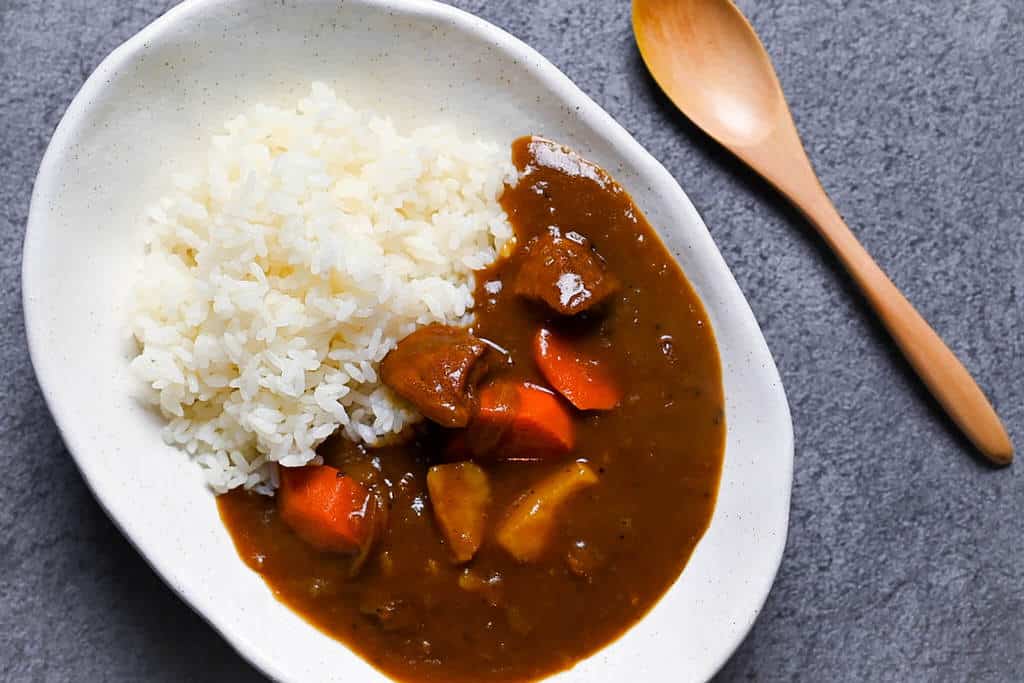
Choosing the Right Japanese Curry Roux
The chocolate bar-shaped Japanese curry roux comes in many brands, spice levels, and flavor varieties, so here are some valuable things to know.
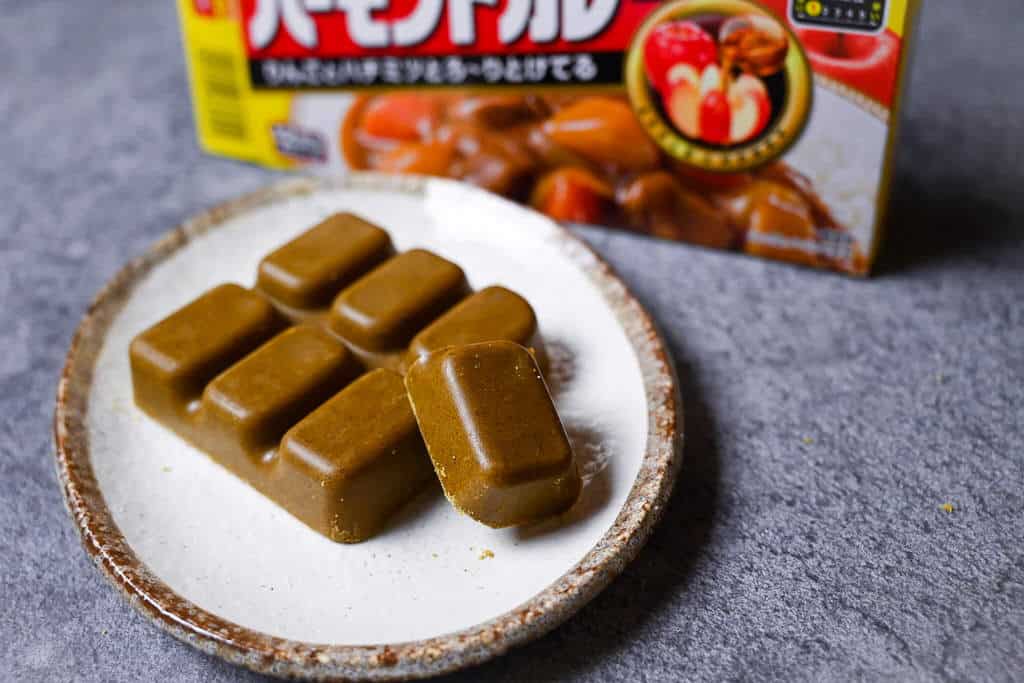
Levels of Spiciness
There are three primary levels of spiciness when it comes to curry roux in Japan, ranging from sweet and mild to hot and spicy. Here are the symbols that you need to look out for.
- 甘口 (amakuchi) – Sweet, mild, and even kids can easily eat it. Not spicy at all. Usually labeled as level 1-2.
- 中辛 (chuukara) – A little spicy but still pretty easy to handle. They are usually labeled Level 3 in spiciness.
- 辛口 (karakuchi) – Hot and spicy curry roux will usually be labeled as level 4,5, or 6, with 6 being the spiciest. Great for spice lovers.
Sticking with the middle option is always a safe bet if you’re unsure.
Recommended Curry Roux Brands
There are so many different brands to choose from that it can be overwhelming, especially if you’re in a Japanese supermarket or shopping online.
Read more about the characteristics of these brands below.
Golden Curry
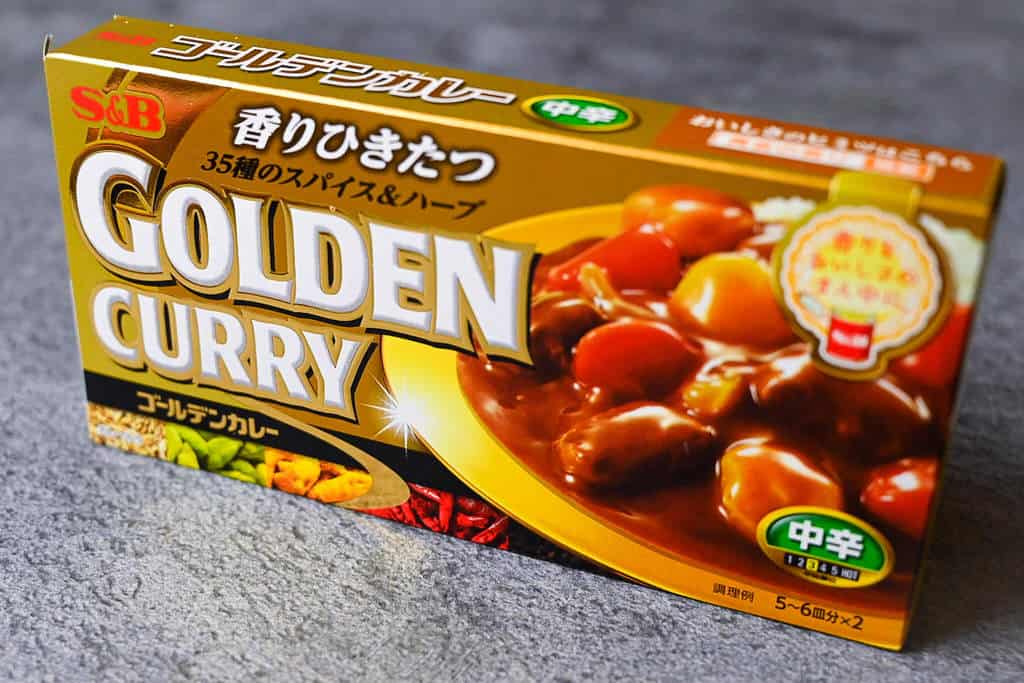
As far as I know, Golden Curry by S&B is the most accessible brand outside Japan. I even saw it in Sainsbury’s (a U.K. supermarket chain) when I lived in England.
You can buy mild, medium, and hot S&B Golden Curry on Amazon. I recommend getting one of each, or you can purchase it as a bundle for a lower price here.
Characteristics:
- The aroma of different spices (many people in Japan say Golden Curry has the most excellent aroma)
- Spicier than average Japanese curry
- Rich flavor
Vermont Curry
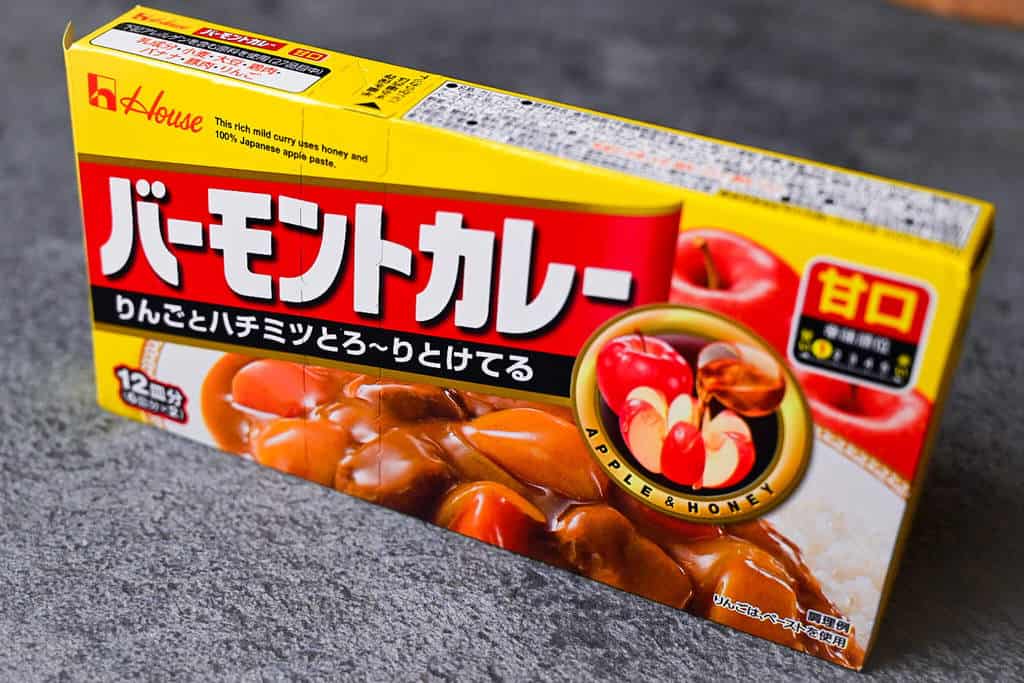
I’ve always known Vermont Curry by House as the curry with the apple and honey on the package. As you can expect, Vermont Curry is sweeter than the others and smells a bit sweet too.
You can buy mild or medium Vermont curry on Amazon.
Characteristics:
- Sweet flavor and smell
- Fruity
- Lighter in color
- Kid-friendly
Java Curry
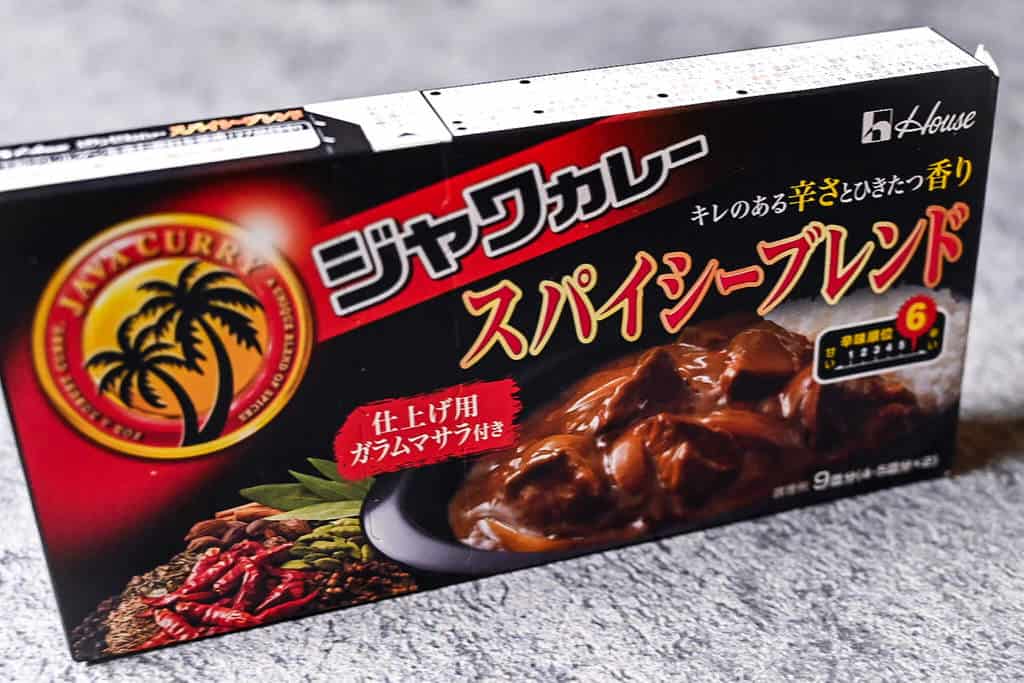
Even though it might not be as accessible as the two above, Java Curry has always been my favorite. It’s known as a spicy brand, and its products have many different spice levels. The one in the picture above is the spiciest curry by Java.
You can buy medium hot and hot Java curry on Amazon.
Characteristics:
- Spicy and hot
- Rich and sharp
- Slightly sour
Other brands available in Japan
There are many other curry roux brands available in Japan, such as:
- Kokumaro Curry (こくまろカレー) – Rich and creamy (Medium and Hot available on Amazon)
- Dinner Curry (ディナーカレー) – Elegant.
- Zeppin – Rich and spicy. (Hot and Sweet available on Amazon)
- Premium Juku Curry (プレミアム熟カレー) – Complex flavor.
- S&B Curry Prince (カレーの王子さま) – Especially for kids, sweet and mild taste.
- PLATINUM – Most gourmet and expensive curry blocks I have found in Japan so far, made by CANYON SPICE company.
The Reason Why I Mix Different Brands
Even though each product has many different spices, I always mix at least 2-3 different brands. Why? I don’t have a logical explanation for it, but I genuinely believe that one secret of good Japanese curry is jumbling all the different flavors to a certain degree.
I usually try to mix at 2-3 different spice levels (Sweet, Medium, Spicy) because that way, you can get the sweet apple and honey flavor from a mild one like Vermont and complex spiciness and heat from brands like Java.
Mixing brands is a common thing you can see in ordinary Japanese home cooking as well. If you use one brand and stick to the instructions, your curry won’t be unique. Complexity is key.
For this recipe, I mixed two cubes of golden curry (medium), two cubes of Java (hot), and two cubes of Vermont (sweet).
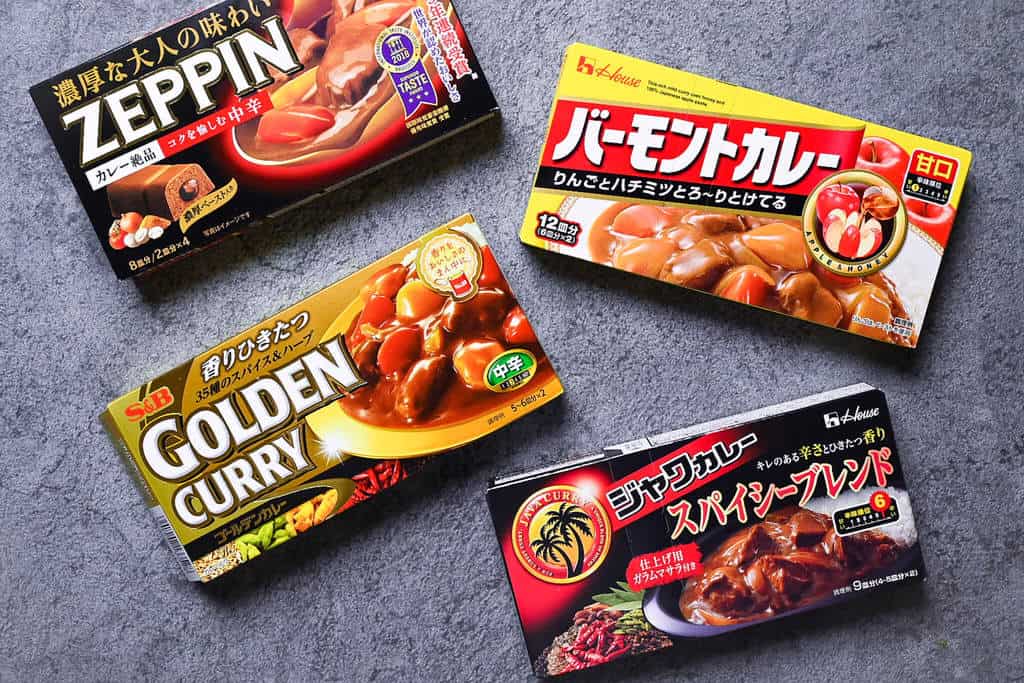
If you want to experiment with different brands, I highly recommend these bundles on Amazon.
Protein/Meat Options
After buying a few of these Japanese curry blocks explained above, it’s time to consider what kind of meat you want. Although beef curry is classic for Japanese curry rice, it’s not uncommon to use other protein sources.
In this section, I will explain popular meat options people opt for in Japan.
Beef
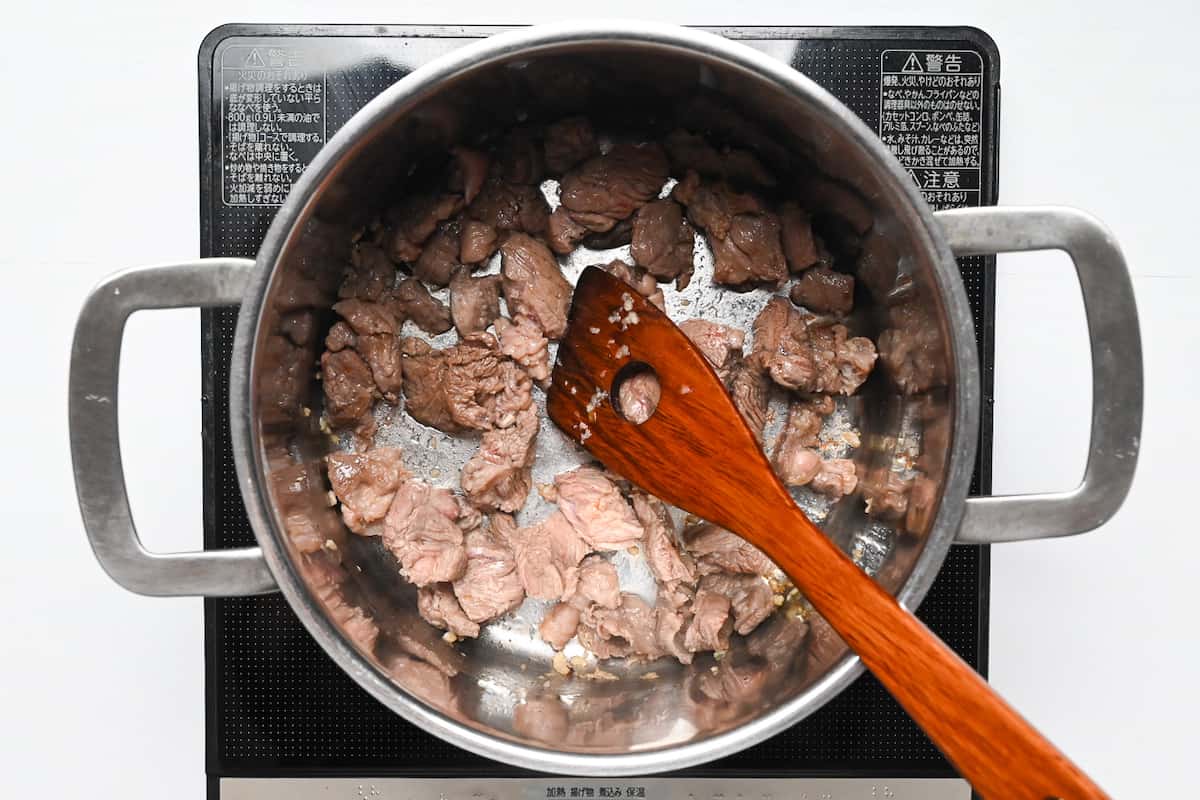
As I mentioned, “the Japanese curry rice” is beef curry. Beef gives it an incredible richness and flavor to go very well with Japanese-style curry roux. However, choosing part of beef to use is very important.
- Short ribs
- Shank
- Sinew
- Shoulder loin
Whichever part you choose should be cut into small chunks (like when you make beef stew). I mostly opt for 70% shank and 30% sinew.
Beef shank and sinew are the parts that become more tender as they are stewed. However, I limit beef sinew to about 30% because its texture can be chewy (but if you stew for too long, it melts into the curry) and has considerable fat, even though the dissolved collagen makes the beef curry richer. I also want beefy meat in my curry!
I recommend beef shoulder if you want a cut that does not require so much braising time.
Pork
The good thing about using pork instead of beef is it’s easier, cheaper, and quicker to cook. You can also use most parts of pork for Japanese curry.
- Shoulder
- Shoulder loin
- Loin
- Medallion
- Belly
- Leg
When choosing, you should consider whether you want to make your curry lean or fat and rich. I recommend pork leg or medallion if you prefer lean, easy-to-eat pork curry.
On the other hand, if you want to enjoy the richness of fatty meat, pork belly is the best choice. Cut the block into cubes and use them to enjoy a rich pork curry. I would say shoulder, shoulder loin, and loin would be between those.
Chicken

You might be surprised, but chicken is not as popular a meat choice as beef and pork for Japanese-style curry. However, I’m not saying chicken doesn’t work! More than anything, it’s pretty important to choose the right parts of the chicken.
- Thigh
- Wings
- Drumsticks
I recommend thighs, wings, or drumsticks for the best result for Japanese chicken curry. If you have time, use chicken wings and simmer them until the meat comes off the bones to make a chicken curry full of rich flavor. Chicken thigh is more for a quicker option.
Chicken breast is passable, but I think it’s too lean and dry to go with Japanese curry. I feel like chicken breast and curry roux don’t mingle well, in my opinion.
Seafood
I must say, seafood is a hidden gem for Japanese curry. If I have to rank the protein ingredients, seafood comes second after beef for me. It’s that good, and I would like you to try it someday! The umami from different varieties of seafood is indescribable.
- Shrimp/prawns
- Squid
- Mussels
- Scallops
Unlike the other meat options, it’s important to use a few different seafood and mix rather than choosing one here. So I recommend using a small portion of each seafood or frozen seafood mix!
Also, seafood options for Japanese curry are endless; you can experiment with other seafood from your area (for example, crab, lobster, etc.).
I actually have a seafood curry recipe, so please check it out if you’re interested!
Three Popular Vegetable Variations
Once you choose the meat/protein option, now it’s time to consider vegetables to use for your Japanese curry. This section will explain a few popular variations for your inspiration.
Classic Curry Trio: Onion, Carrot and Potatoes
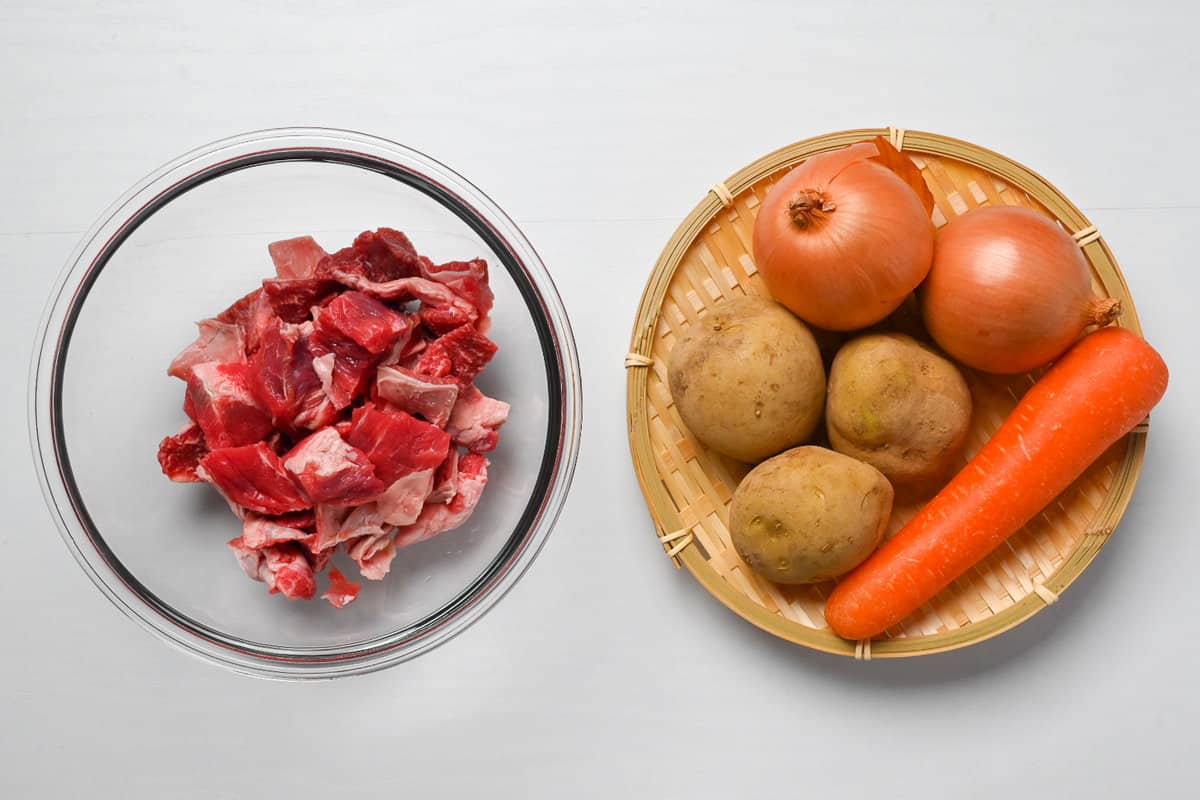
The most standard home-cooked Japanese curry has onion, carrot, and potatoes. What is so good is wherever you live in the world, you can get these ingredients easily.
I recommend this standard vegetable combination if you have never had Japanese curry.
- White onion
- Carrot
- Potatoes
Summer Curry: Eggplant, Okra, Pumpkin…etc
This combination is also known as “summer vegetable curry” in Japan. Tomatoes, zucchini, and bell peppers are also commonly used, and many summer vegetables are beautifully colored, making the dish vibrant and fresh.
The difference is that these vegetables are grilled separately rather than simmered with the curry roux. This is because many summer vegetables are soft and lose shape and texture.
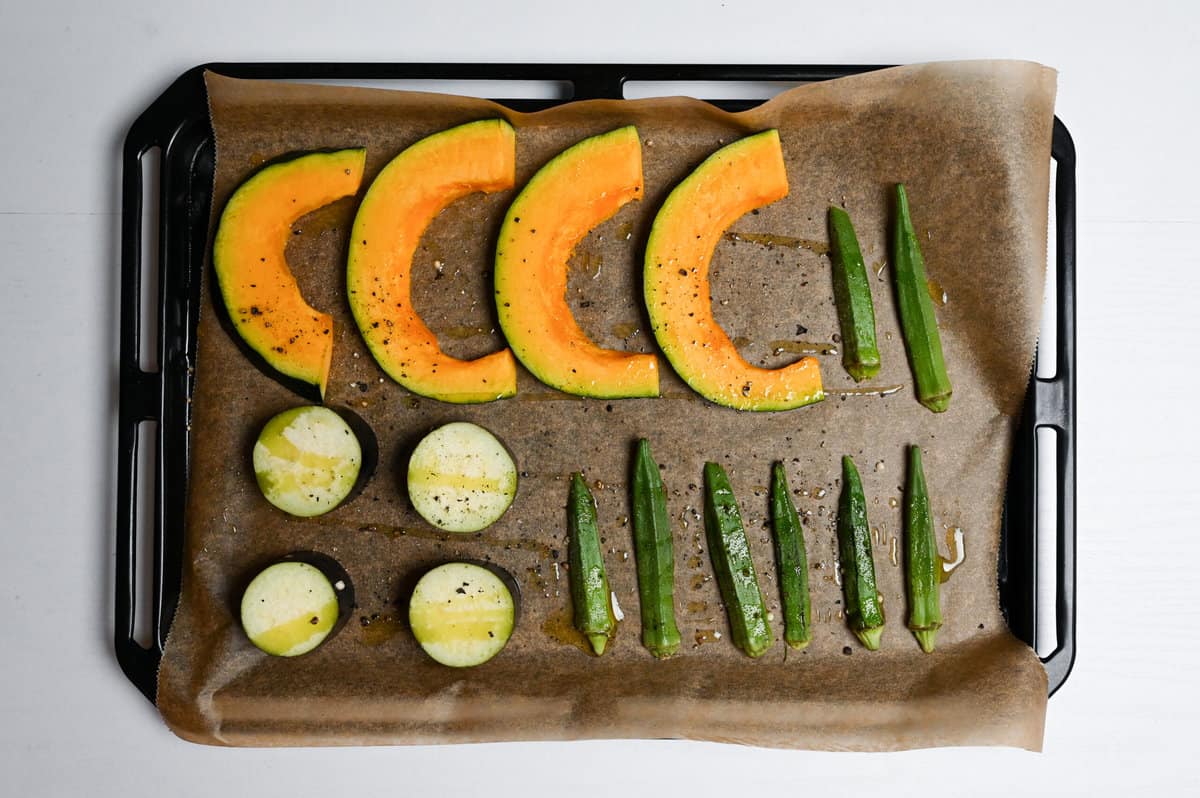
Some people even use grilled tomatoes for summer vegetable curry!
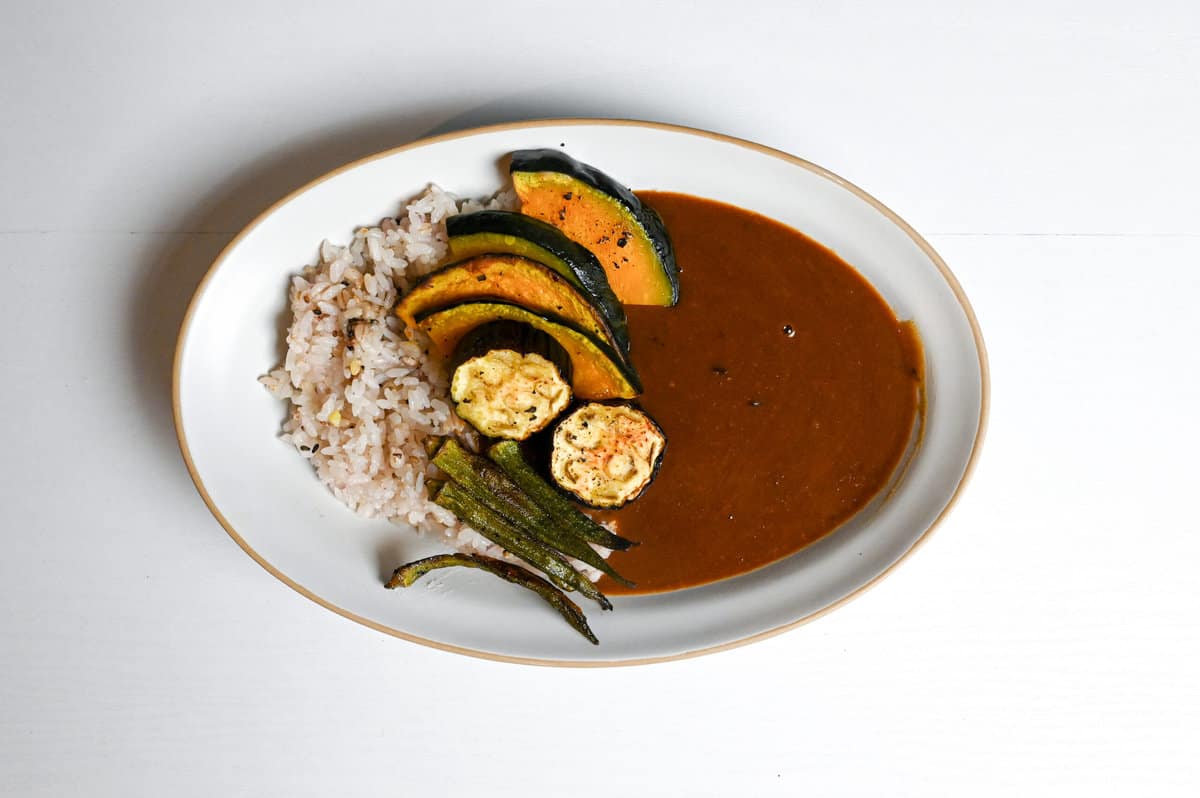
- Eggplant (Aubergine)
- Okra
- Pumpkin
- Bell pepper
- Tomato
- Zucchini (Courgette)
- Goya (bitter melon)
Winter Curry: Turnip, Broccoli, Napa cabbage…etc
On the contrary to summer vegetables, these are the winter vegetable variation. Since there are more root vegetables, they will taste even better when cooked together. However, some exceptions include vegetables like broccoli or spinach, as they can break easily in the roux, so it’s best to boil and garnish them at the end.
- Turnip
- Broccoli
- Sweet potatoes
- Napa cabbage
- Spinach
- Lotus roots
- Cabbage
However, there is no rule about which vegetables to use for Japanese curry. My best advice is to use your local and favorite ingredients and experiment! Remember, creativity is always a key to making Japanese curry.
Water Substitutions to Maximize Flavor
So all the curry roux cubes will tell you to mix with x amount of water, but you’re certainly not limited to plain water. The liquid added to curry is yet another opportunity to add extra flavor.
This section will list a few alternative liquids you can add to your Japanese-style curry instead of plain water. These range from not-so-scary to quirky ones you probably haven’t heard of.
Be careful when using liquids with salt, as it can make the curry too salty.
Unsalted stock/broth
If you can get unsalted beef, chicken, vegetables, etc., these would be a significant flavor boost for Japanese curry.
Stock powders/Bouillon
Since stock powders can be pretty salty, you must be careful if you want to add them. I recommend using water initially, then adding small amounts of stock cubes/powders after mixing in the curry roux. This way, you can taste test as you go to prevent having an overly salty curry!
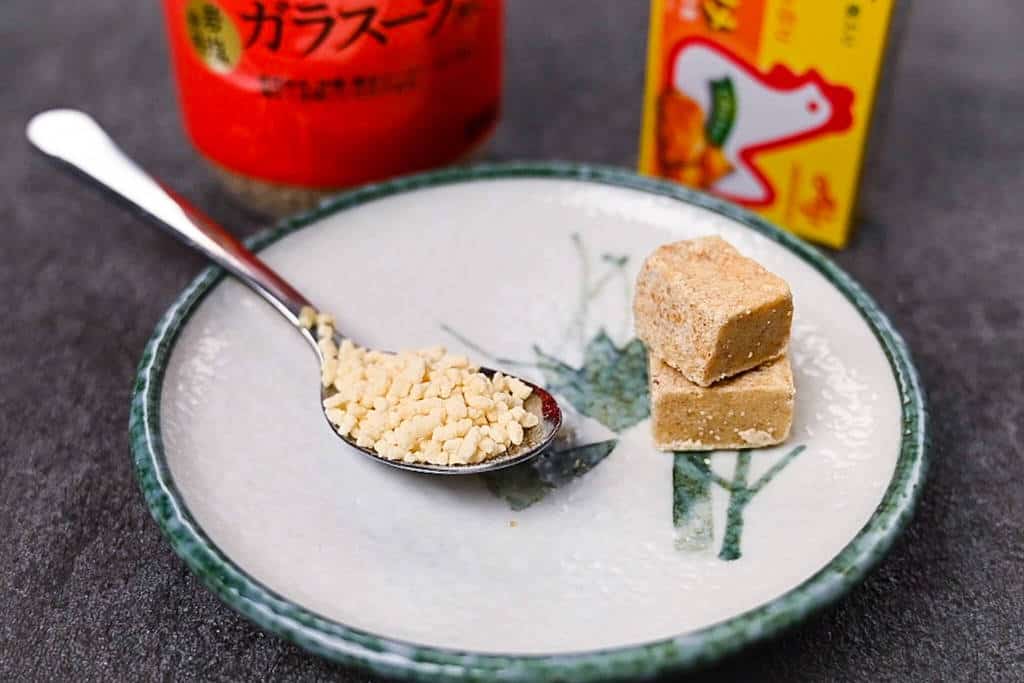
Dashi stock
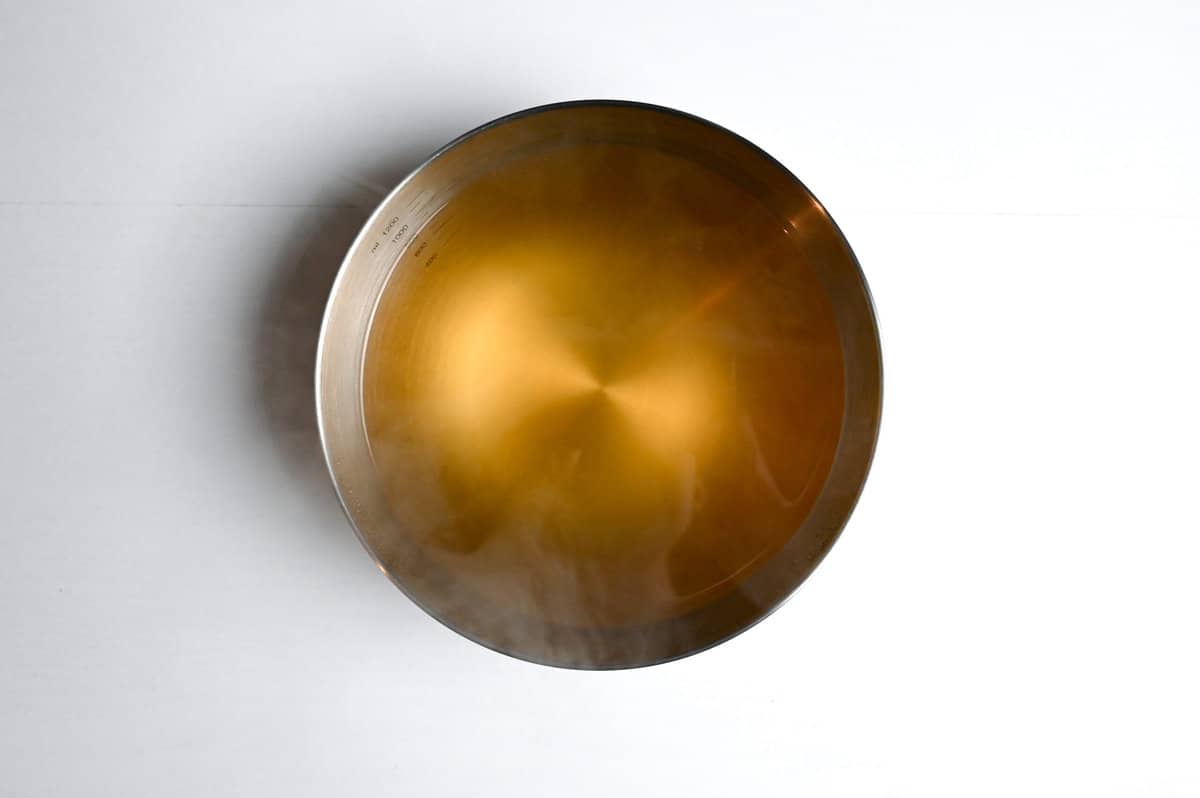
Do you want to make your curry extra Japanesey? In that case, you might consider using dashi stock for the liquid. The good thing about dashi is that they don’t contain any salt, so you can use it to replace the water.
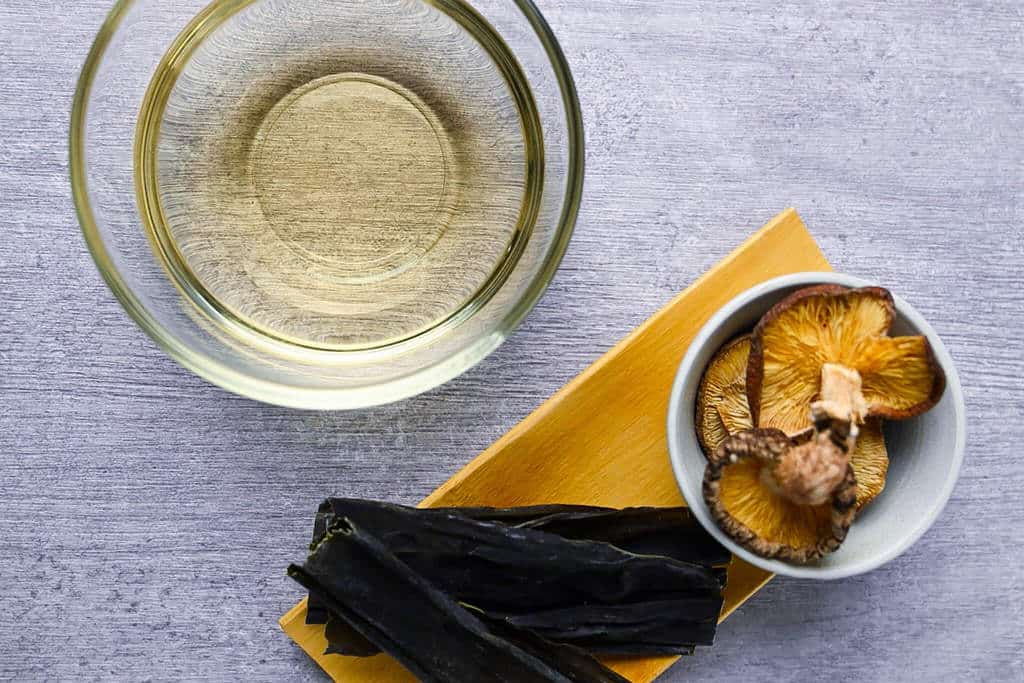
Some Japanese curry specialty restaurants use this technique as well. If you’re interested in making dashi, I have a recipe for homemade dashi here!
Fond de veau
If you want to make your curry more elegant, French fond de veau is a great option! Fond de veau is a French broth made by simmering veal bones and meat with aromatic vegetables and other ingredients for a long time.
Even in Japanese supermarkets, fond de veau jelly/powder is sold in the Japanese-style curry aisle, so it’s safe to say this is a top choice!
Black tea
This is the quirky one that I was talking about. This is an idea that I found when I was randomly watching a TV show a few years ago. The show featured the Curry Development Society at Kyoto University (one of the best universities in Japan). Interestingly, one of Japan’s most brilliant people studies curry as a club activity, but using black tea for curry was mind-blowing.
According to them, the use of black tea mellows the curry. The program was exciting as it introduced various other science-based techniques. But instead of substituting all water for tea, you may start with a small amount.
Wine / Juice
Other than these, you can replace 10% of the water with red wine for beef/pork curry or white wine for chicken or seafood curry. If you don’t want to use alcohol, you can use a bit of apple juice, grape juice, or something like that instead!
Jump to Full RecipeType of rice to serve with Japanese curry
You might wonder what kind of rice works best with Japanese-style curry. The short answer is short-grain Japanese sticky rice (Japonica rice). Like some other curries in the world work better with long-grain rice (for example, Indian curry or Thai curry), Japanese-style curry works best with short-grain rice.
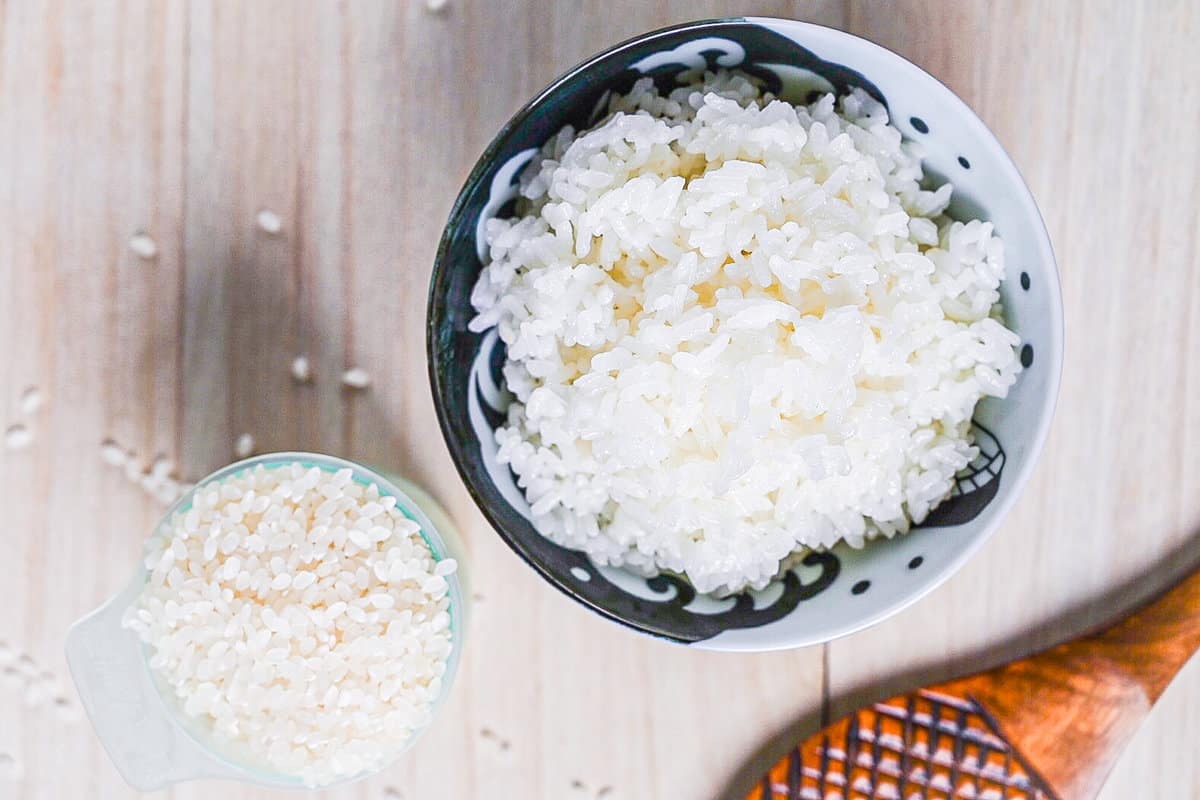
Incidentally, more than 300 rice varieties are grown in Japan, and more than 1,000 rice varieties are grown worldwide. The rice grown in Japan is collectively called “japonica rice,” characterized by its rounded oval shape, stickiness, and sweet taste.
- Koshihikari (コシヒカリ)
- Akita komachi (あきたこまち)
- Hitomebore (ひとめぼれ)
- Haenuki (はえぬき)
- Sasanishiki (ササニシキ)
Look out for these types for the most authentic Japanese curry experience! If you want to cook Japanese-style rice without a rice cooker, check out my How to Cook Japanese Rice on Stove recipe.
If you don’t mind extra effort for richer Japanese curry rice, you can make the garlic rice that I used in my Hayashi Rice recipe.
7 Topping variations
Now, we come to the topping section. You can customize your Japanese-style curry using all the techniques we have discussed, but you can also make a big difference with toppings.
So in this section, I will list every popular curry rice topping in Japan and explain how they can change your Japanese-style curry.
Fukujinzuke pickles
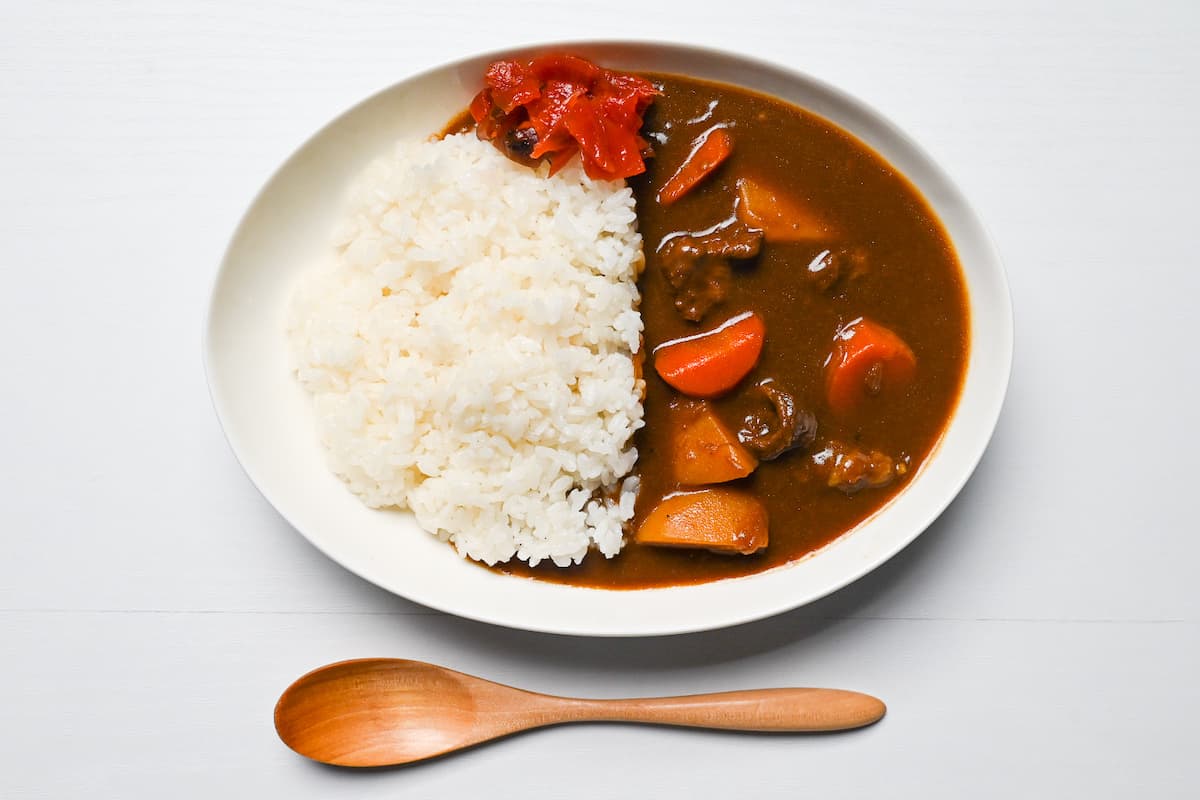
Fukujinzuke is a non-fermented sweet pickle made by seasoning vegetables such as radishes, eggplants, lotus roots, cucumbers, and shiitake mushrooms with soy sauce, sugar, mirin, and other seasonings.
I said, “topping variation,” but this is almost a must-item to go with Japanese curry. I personally think it’s not complete without fukujinzuke.
You might recognize it as “red pickles,” but the red color is made by food coloring to make it contrast with the dark curry roux. Naturally, fukujinzuke is orangey brown.
Shredded cheese
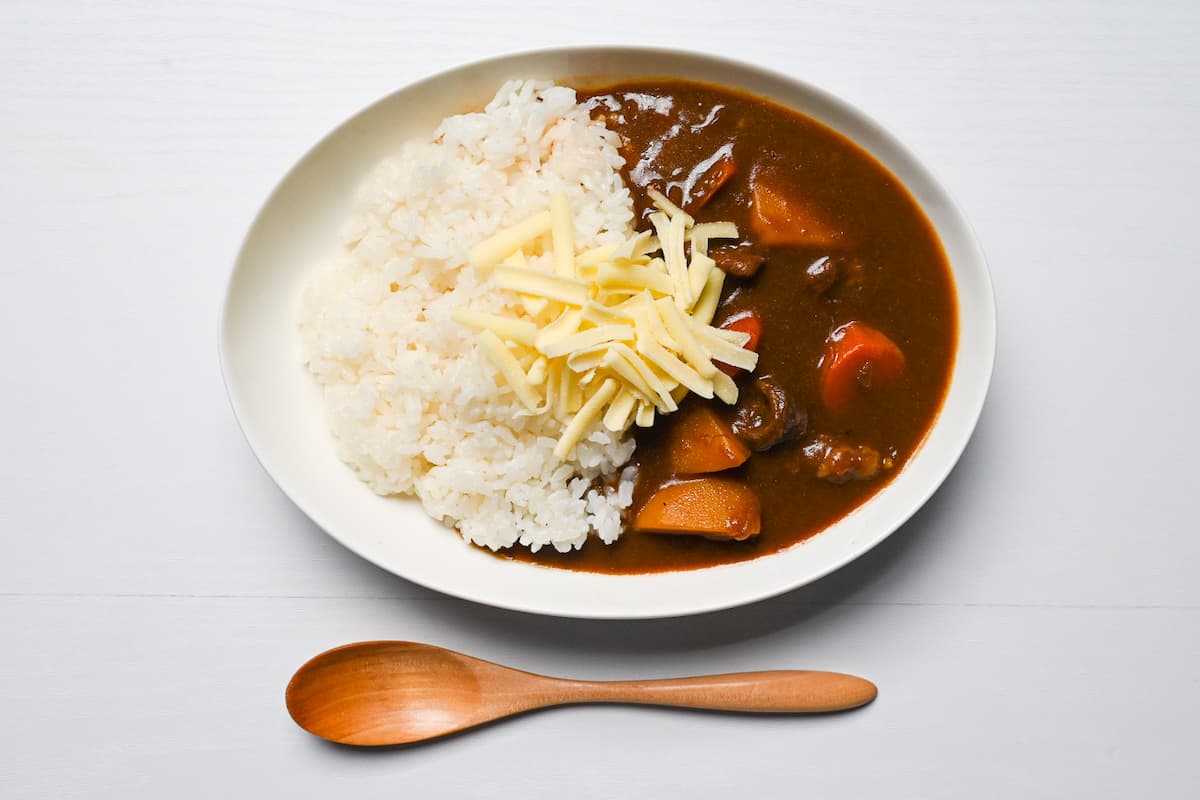
Melty cheese is also a popular topping option for Japanese curry. The addition of cheese gives the curry a unique dairy richness and depth. It may also soften the spiciness of curry when it is too hot. Other than shredded cheese, some people use powdered cheese for a tangier taste.
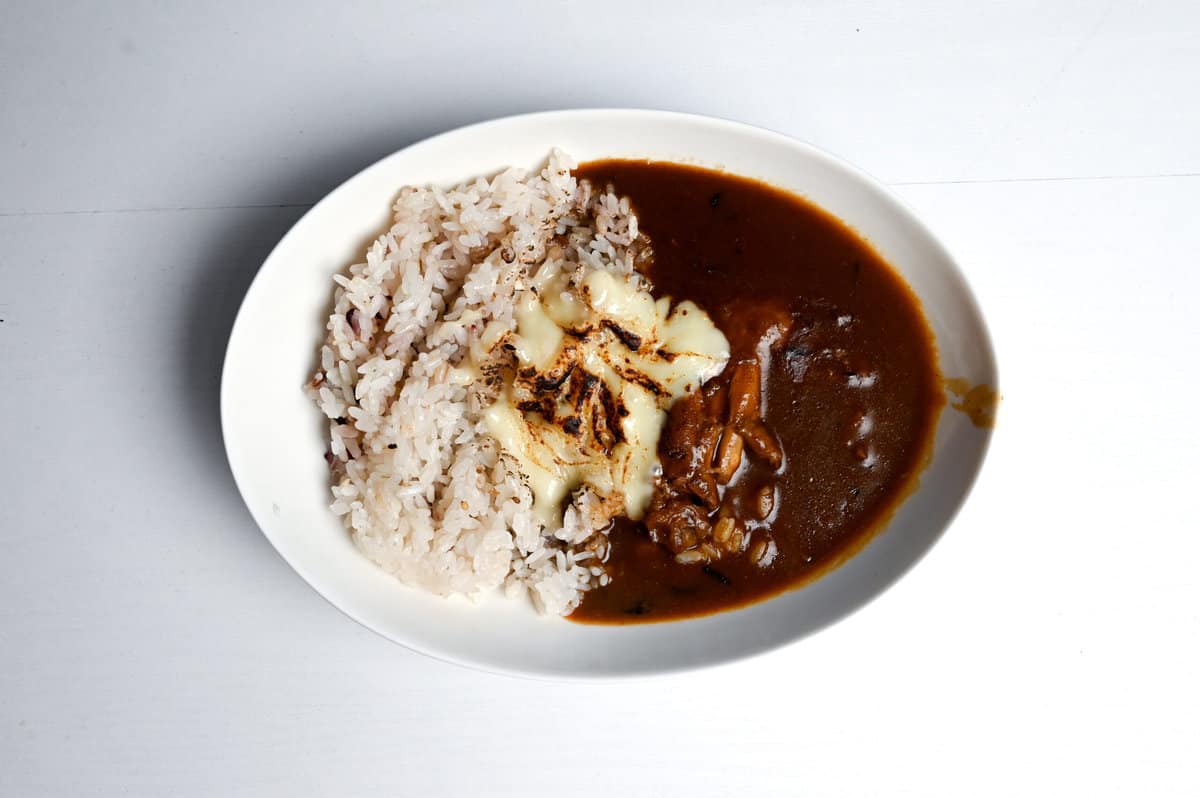
If using melty cheese, I’d recommend cheddar or gouda cheese, and if using powdered cheese, Parmesan or Pecorino cheese will add a more robust cheesy flavor to Japanese curry.
Egg
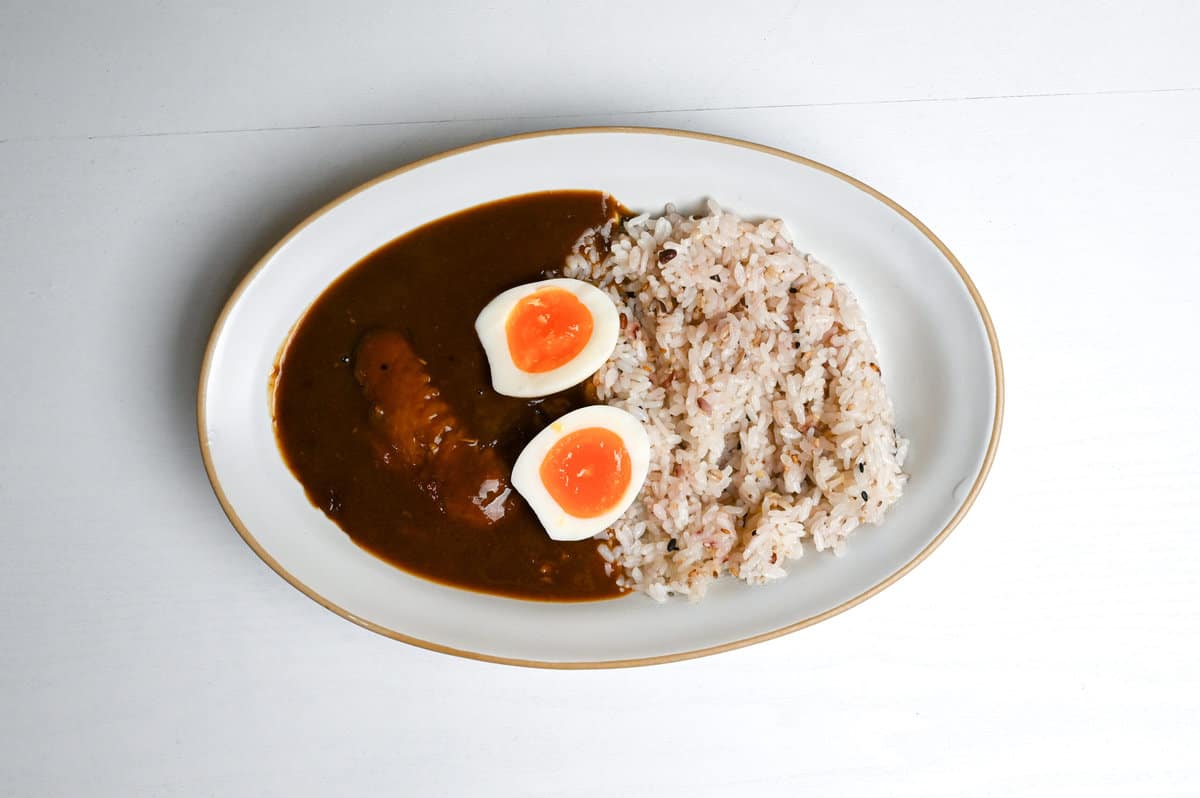
Eggs as a topping for curry can be used in all forms: raw, semi-cooked, onsen, boiled, and fried. I especially recommend the half-boiled egg, which blends easily with curry.
It is a popular topping in Japan because the curry roux becomes milder when mixed with egg and is a common household ingredient you likely already have in your fridge.
Tonkatsu
Tonkatsu is a Japanese deep-fried pork cutlet. You might already know it, but when Japanese-style curry topped with tonkatsu is called “katsu curry.” It’s safe to say it’s the ultimate version of Japanese curry, and it’s so good.
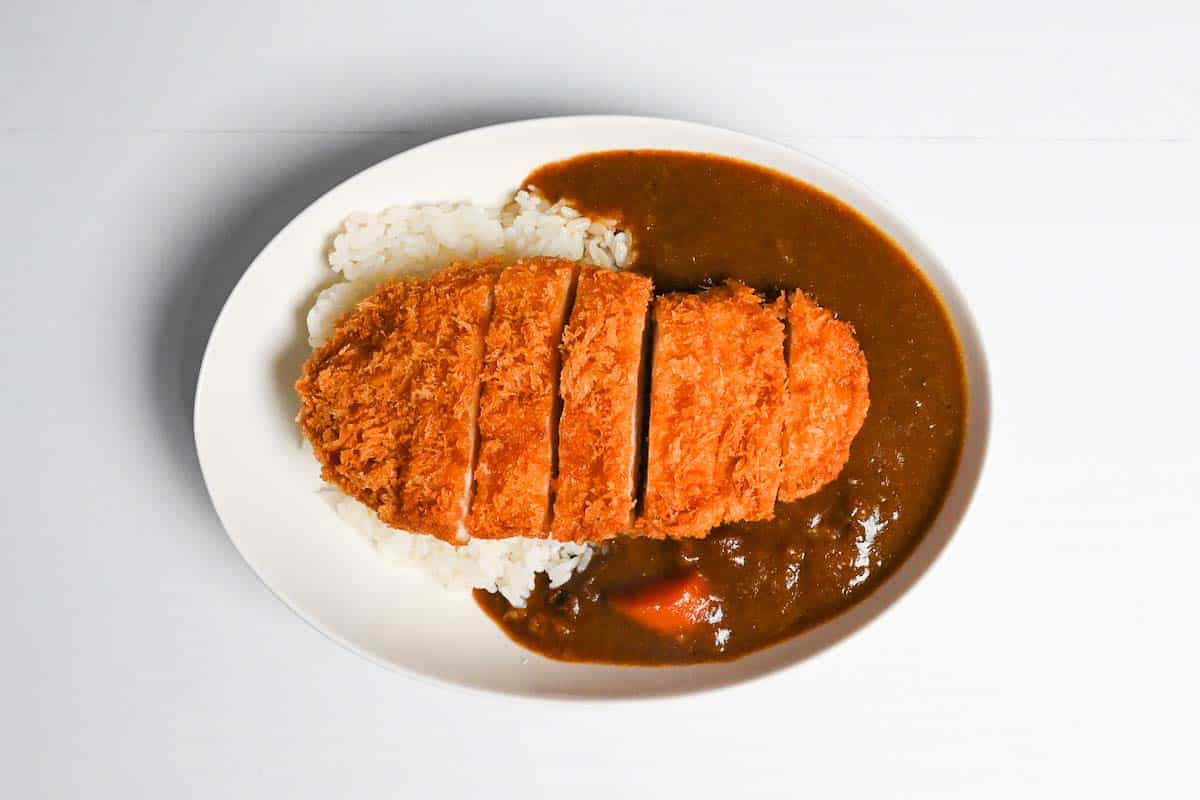
To make an ultimate homemade tonkatsu, check out my Tonkatsu recipe! You can also make it with Chicken Katsu variation as well!
Karaage
Karaage is a Japanese-style fried chicken, and it’s not as popular a topping as tonkatsu, but many people like it with Japanese curry.
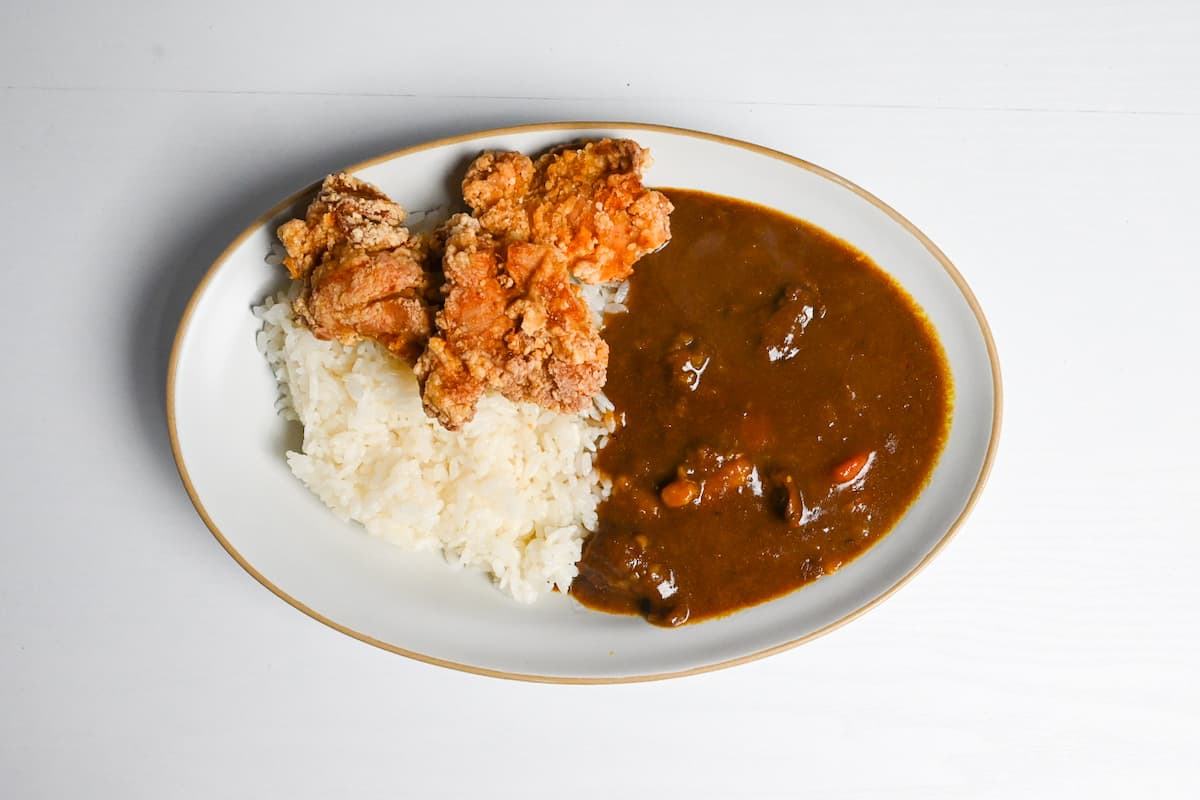
If you want to use Japanese fried chicken as a topping, you can check out my Karaage or Tatsuta age recipe.
Rakkyouzuke
Rakkyo (Allium Chinense) is a vegetable from the Liliaceae family and the leek genus. In English, it has many names, such as “Chinese onion,” “Chinese scallion,” and “Japanese scallion,” and looks a bit like a cross between a garlic clove and a shallot. It has a unique aroma and pungent taste. When rakkyo is pickled in sweet vinegar, it’s called rakkyozuke.
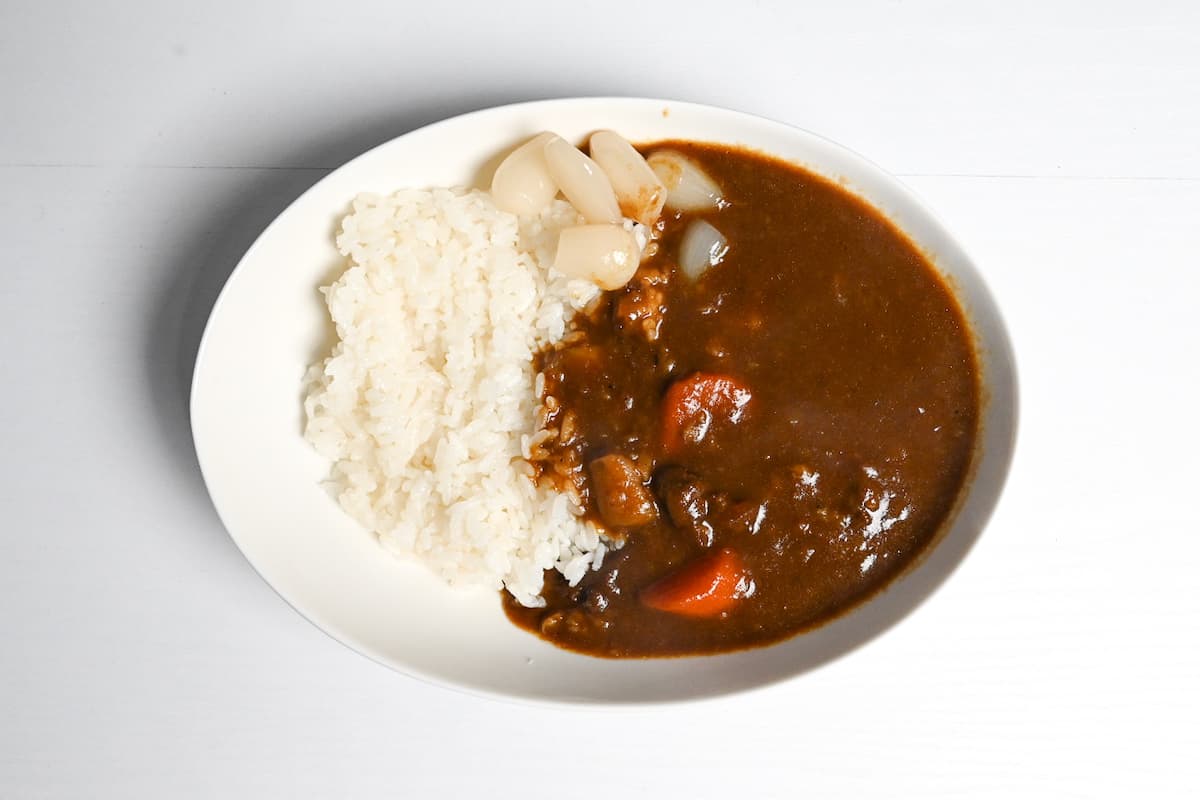
Some people use it as a topping for curry instead of fukujinzuke. While some people love the unique flavor of rakkyo, quite a few dislike it.
Natto
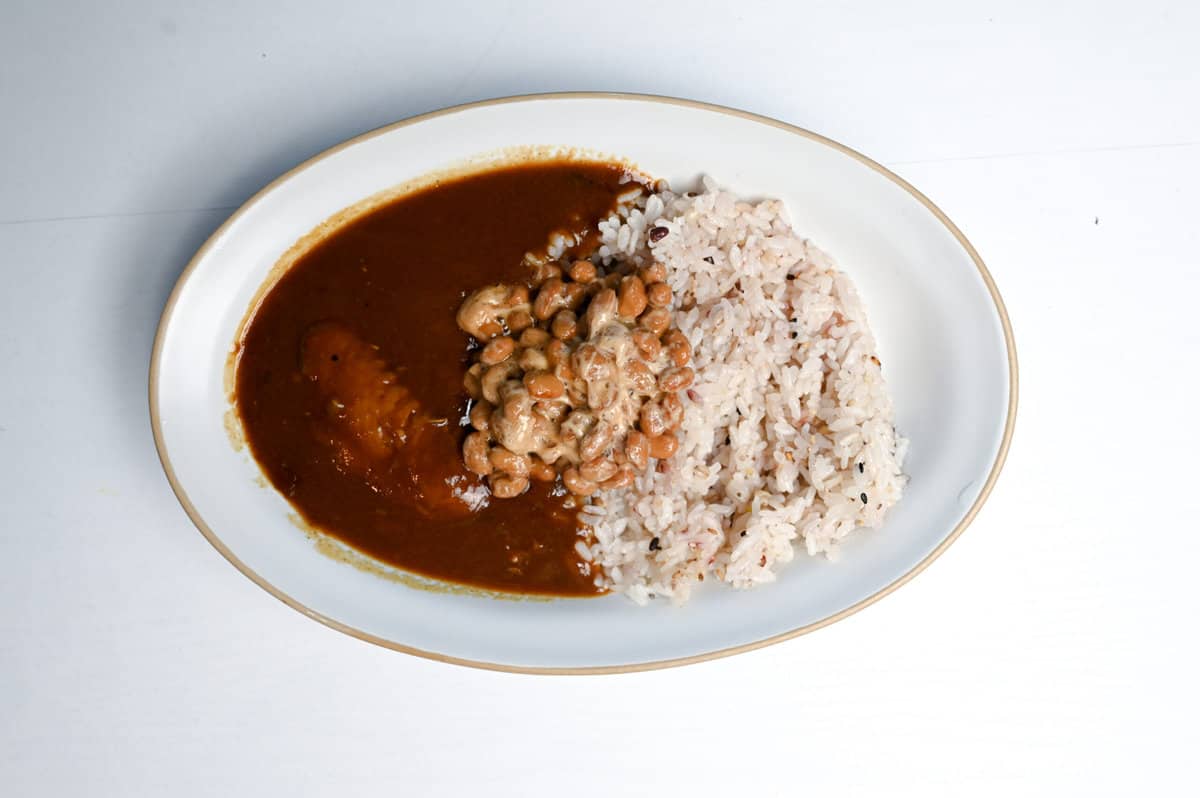
This can be the most surprising topping, but it is one of the most well-known toppings for Japanese curry. Natto is a fermented food made from softened soybeans boiled, steamed, and fermented by the bacillus natto.
You might think, “It’s never going to work,” but they go well together. I liked it as a kid and still like it to this day.
However, natto is a food that can be loved or hated, so do not put it on your curry unless you’re 100% sure you like it first. If you want to know more about natto, I have a comprehensive article about Natto.
Secret tips for making Japanese curry (Surprise Ingredients)
Now we have come to the last part, secret ingredients! Using only curry roux cubes makes excellent curry, but using secret ingredients with roux cubes makes pro curry and rice.
Did you know most restaurants serving curry rice do not make curry from scratch? They often use wholesale roux cubes! So what makes them unique compared to home-cooked curry? The answer is in the secret ingredients.
I’ll give you some ideas of secret ingredients that improve the taste of home-cooked curry rice. Use different secret ingredients every time, and then see how it’s different from the last time!
Caramelized onions
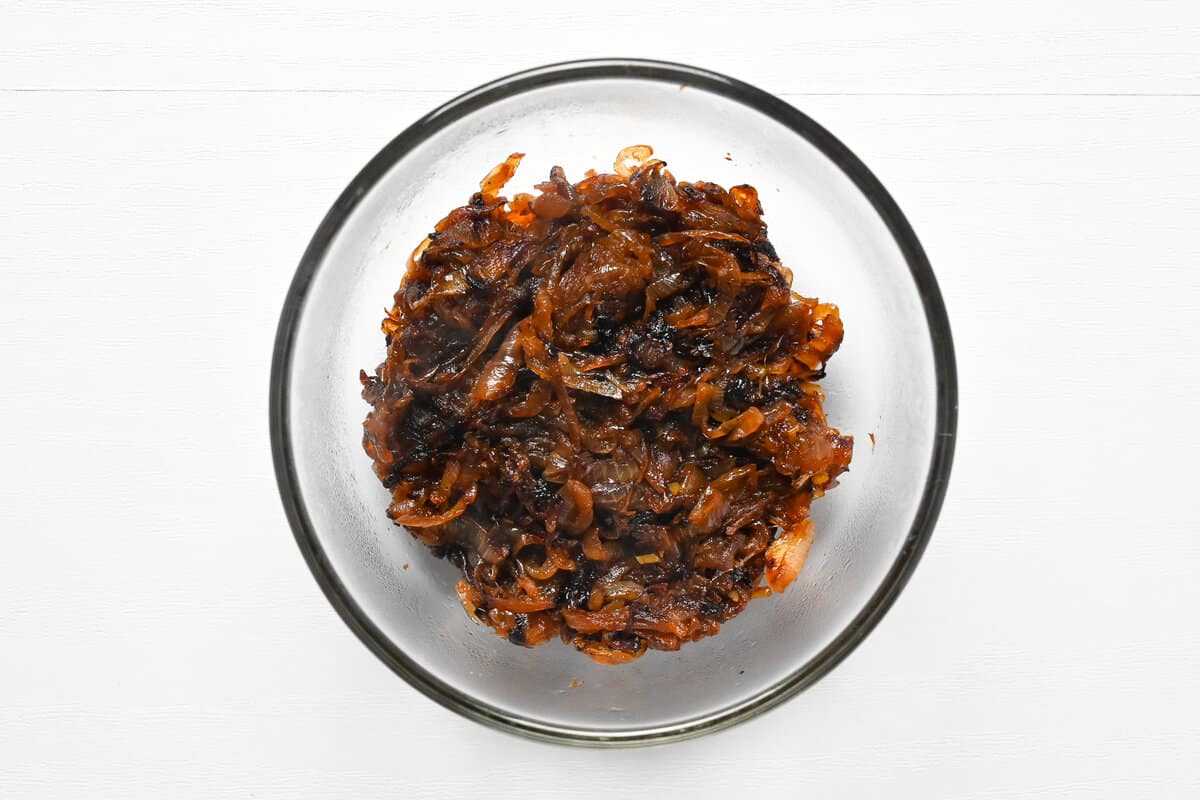
This is a pretty recent discovery for me. I always add onions to curry, and I always thought that frying them until softened is enough. That is until I tried adding “caramelized onions,” which was a game changer!
Whether you have Japanese curry roux or not, caramelized onions will add a rich, gravy-like taste to your curry and improve the color. It’s time-consuming but worth putting in that time to level up your curry. I’ve included steps on how to caramelize onions in the recipe below.
- Timing: 40 mins
- Amount: 1.5 – 2 onions
- Recommended: Someone who wants depth of flavor
- Effect: Richer, more gravy-like taste, deepens the brown color
If you love caramelized onions but don’t want to spend so much time making them every time you make curry, make a large batch and freeze them in smaller batches. Store them in zip lock bags and add them directly to your curry; no need to defrost! Frozen caramelized onions will keep for several months if stored properly. (Be careful to prevent freezer burn or ice crystals forming by ensuring the container/zipper bags are correctly sealed and airtight.)
Chocolate

This one is kind of understandable. A small amount of chocolate will make the curry richer. It’s a secret ingredient, so don’t put too much!
- Timing: After the roux has melted
- Amount: 2-3g
- Recommended: Someone who’s not good with spice
- Effect: Softening the spiciness
Instant coffee Powder
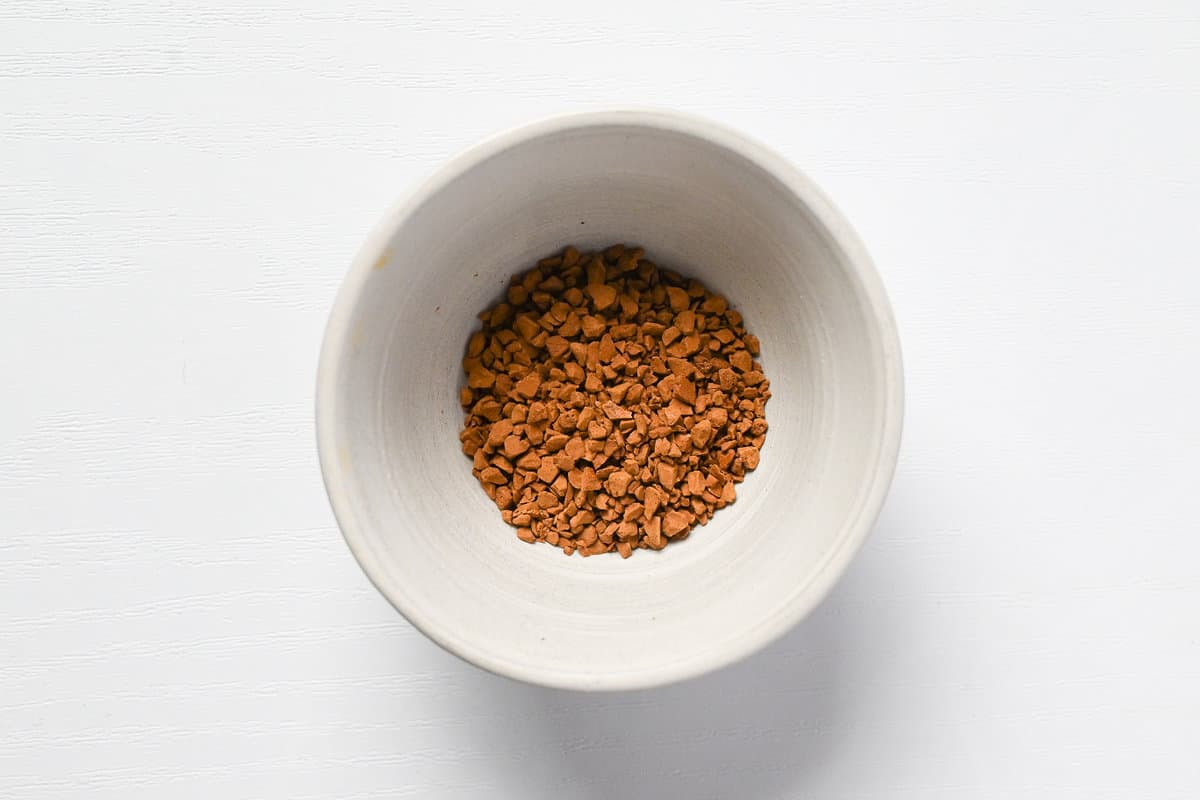
I add instant coffee whenever I make curry and rice with roux cubes. It significantly contributes to a richer taste, for sure! For this purpose, I recommend the dark roast kind!
- Timing: After the roux has melted
- Amount: 2 tsp
- Recommended: Someone who wants a deeper and richer taste
- Effect: Richen the curry
Red wine

This is another secret ingredient that I use regularly. It will add a nice punch to the roux and give it some European stew taste. A dry red like Cabernet Sauvignon or Merlot works great.
- Timing: Same time as the water
- Amount: Substitute 10% of the water amount (so this recipe would be 720ml water 80ml wine)
- Recommended: Someone who wants to add some sourness
- Effect: Making it more refreshing adds a touch of sourness
Soy sauce
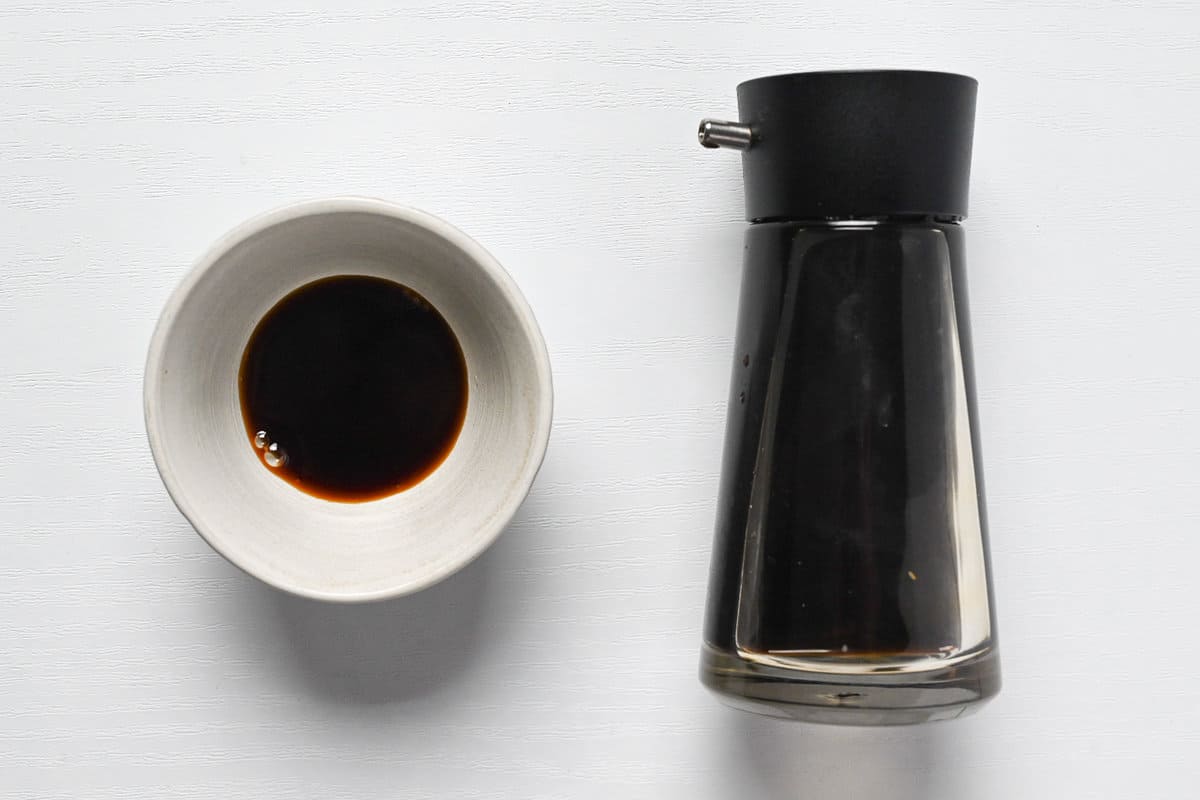
I add a bit of soy sauce every time. As you can guess, it will add a bit more umami and Japanese taste to the curry!
- Timing: Right before the roux cubes
- Amount: 1 tbsp
- Recommended: Someone who wants to add Japanese/Wafu taste
- Effect: Making it more Japanesey / adding umami
Tomato juice/puree/ketchup
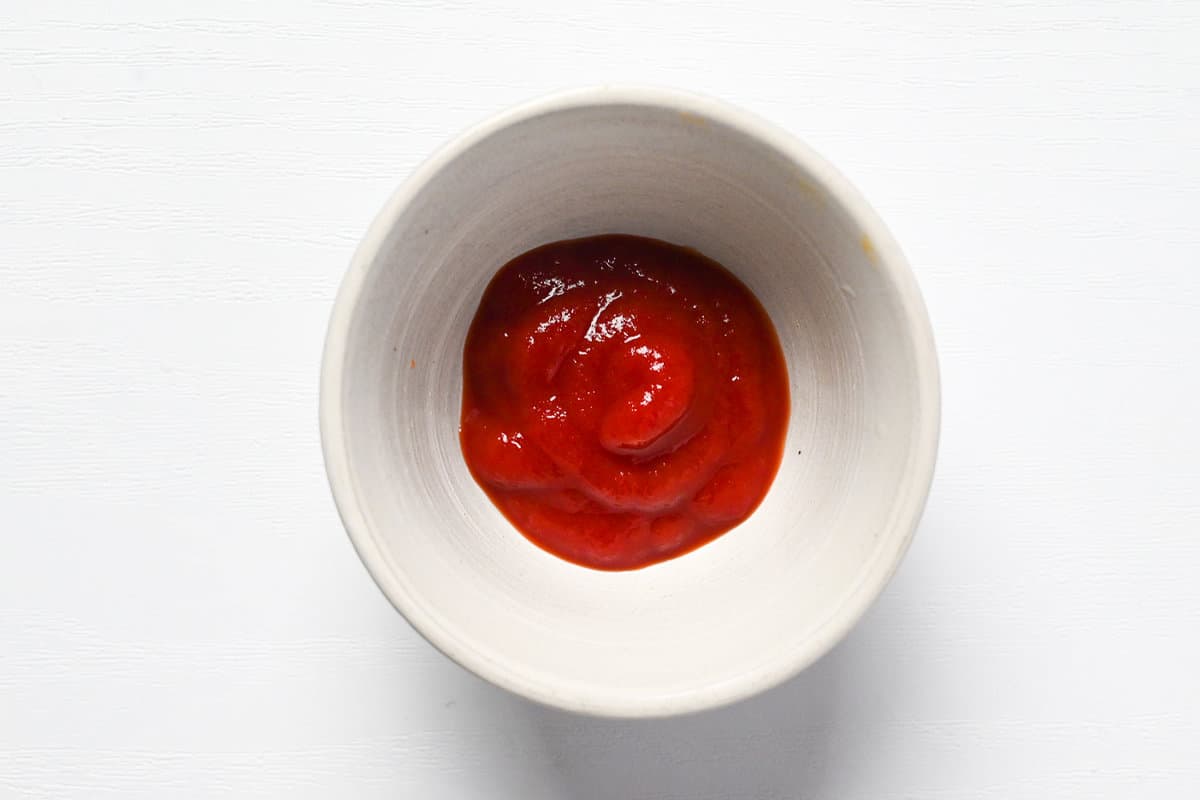
This is a popular addition, but I don’t use it because I’m not a massive fan of my curry being too sweet or sour.
You can add any of these products if you want to add tomato sourness. But be careful with tomato puree; a little goes a long way, and adding too much can make it too tomato-y. (Speaking from my experience)
- Timing: When you add the vegetables
- Amount: 1 tbsp-3 tbsp
- Recommended: Someone who wants to add sourness
- Effect: Making it sour and tomatoey
Additional secret ingredients
There are endless possibilities when it comes to curry, and I’m always on a mission to create the best curry there can be, but in the end, it all comes down to personal preference.
Here are a few more ingredients you can try depending on whether you want to make your curry sweeter, richer, spicier, or more sour.
Sweetness
- Sugar
- Grated apple (peeled)
- Honey
- Jam
- Apple sauce
Spiciness
- Chili powder
- Garam Masala
- Chili sauce
- Fresh chili
- Mustard
Richness
- Butter
- Coffee
- Dark chocolate
- Caramelized onion
- Wine
Sourness
- Worcestershire Sauce
- Ginger
- Tomato Puree
- Canned Tomato
- Wine
If you know any other ingredients that have improved your curry, comment below, and I’ll add them!
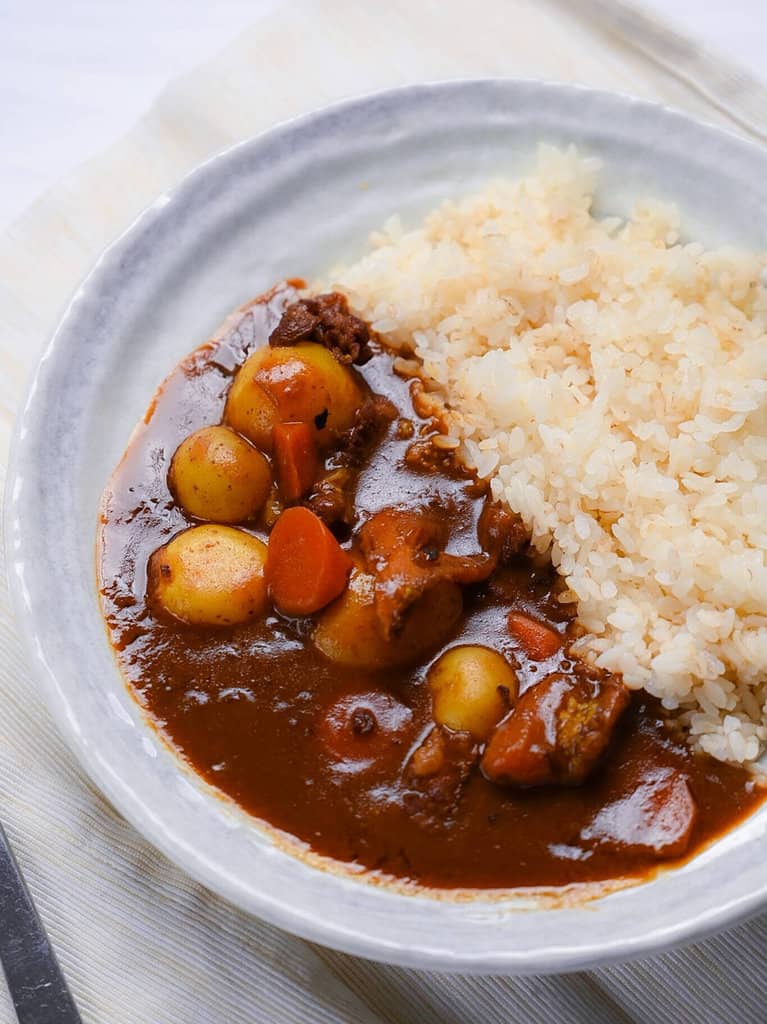
Storing and reheating
Lastly, I will add helpful tips for storing and reheating leftover Japanese curry. As you might expect, there are two methods you can use, refrigerated or frozen. Avoid storing at room temperature to prevent foodborne illness.
Refrigerated for up to 2-3 days
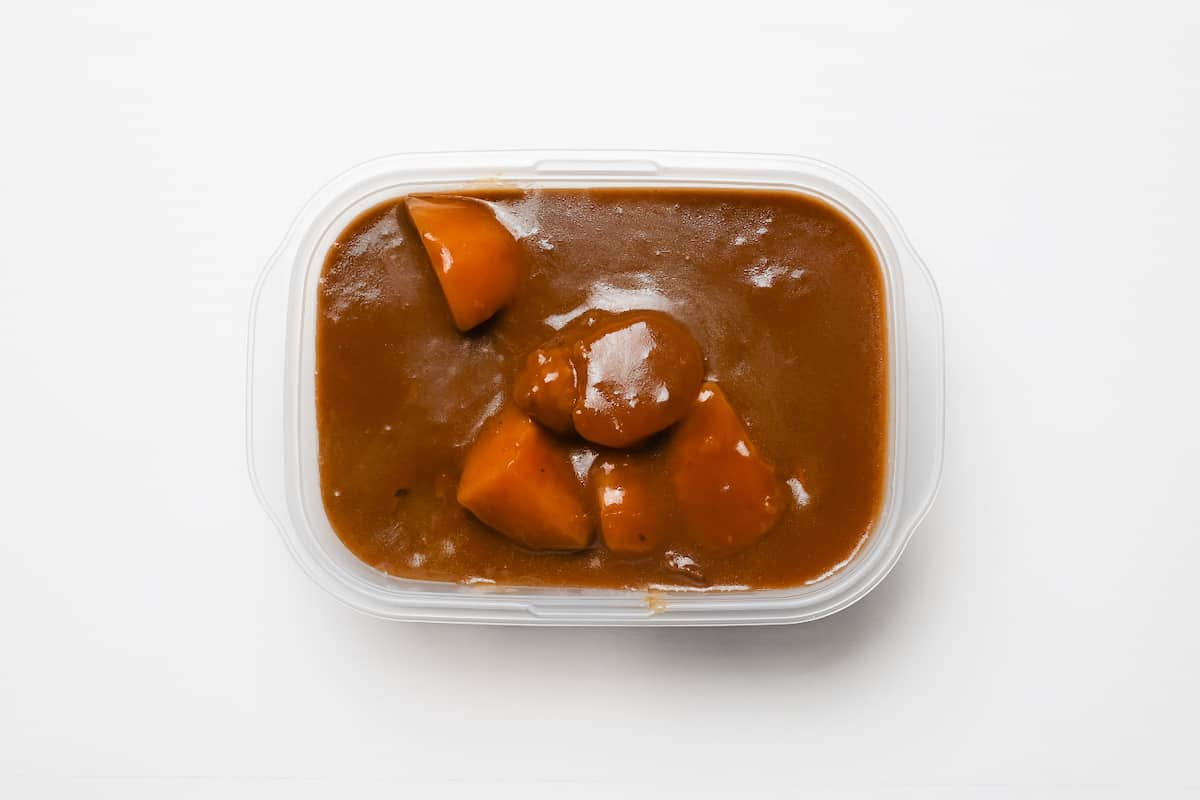
First, remove the pot of curry from the heat and allow to cool for about 20 minutes.
After it’s cooled down, divide the curry into smaller portions, such as one or two servings, and place them in storage containers (preferably glass to prevent staining) or zipped storage bags.
Since storing in small portions allows for quicker cooling, choosing smaller containers rather than large ones is recommended. This is also more convenient for reheating individual portions. If you want to store curry in a zippered storage bag, keep it as flat as possible.
To reheat chilled curry, place it in a saucepan and heat slowly over low heat, stirring constantly.
Microwaving is not recommended as it tends to cause uneven heating; however, if you want to microwave it anyway, microwave for 1 minute at a time and mix well between intervals.
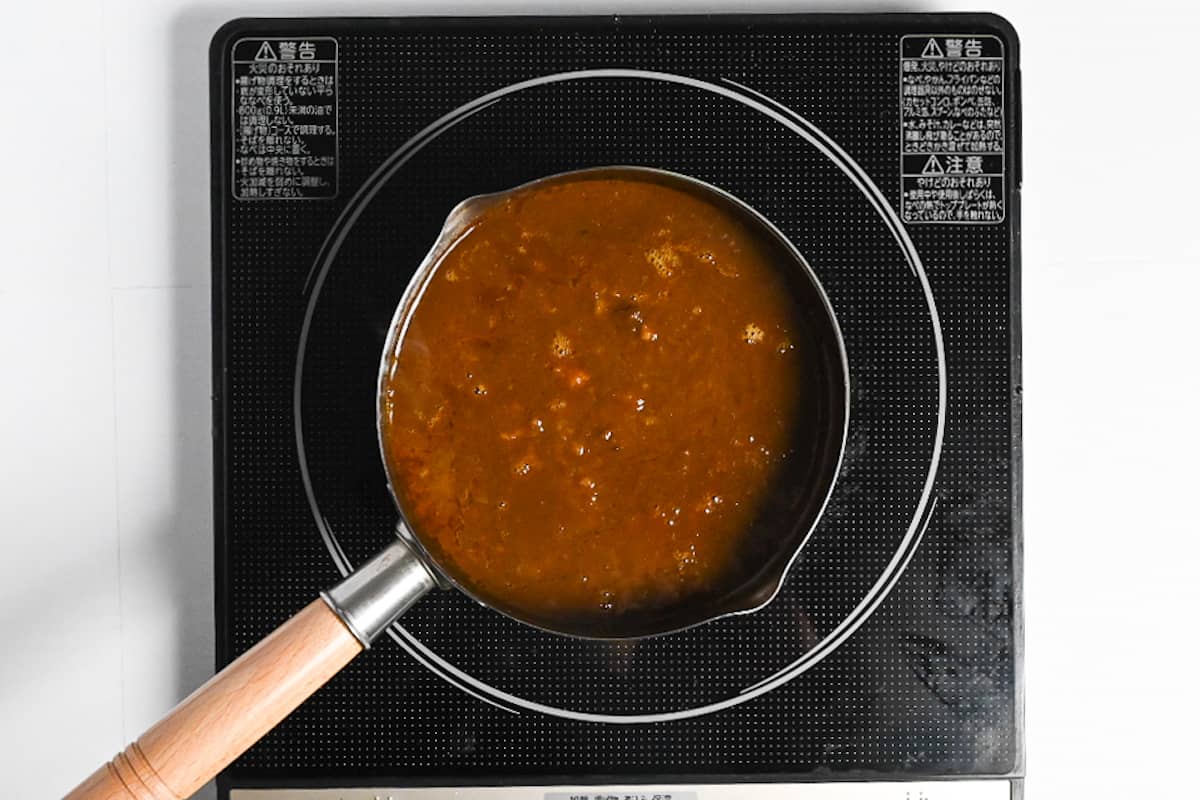
If you can’t eat it in a couple of days, please consider freezing it, as explained below.
Frozen for up to 1 month
The standard storage guideline for freezing curry is one month, which allows for long-term storage, but there are a few things to keep in mind when freezing and reheating from frozen.
When freezing curry, you need to be careful about the ingredients. For example, potatoes and carrots, common vegetables used in curry, will lose water and become dry in texture when frozen, ruining the curry. Potatoes, especially, tend to fall apart after freezing and reheating.
Therefore, remove such ingredients before placing the curry in the storage container.
The recommended method for thawing frozen curry is to place it in the refrigerator and thaw it slowly (overnight). If you freeze your curry in zipper bags, you can defrost it in hot water.
Once defrosted, place the curry in a saucepan and heat slowly over low heat, stirring constantly, just as you would if you had kept it refrigerated.
Microwaving frozen curry removes flavor and moisture, and the taste deteriorates. However, if you want to microwave it anyway, heat it one minute at a time and stir well between each interval.
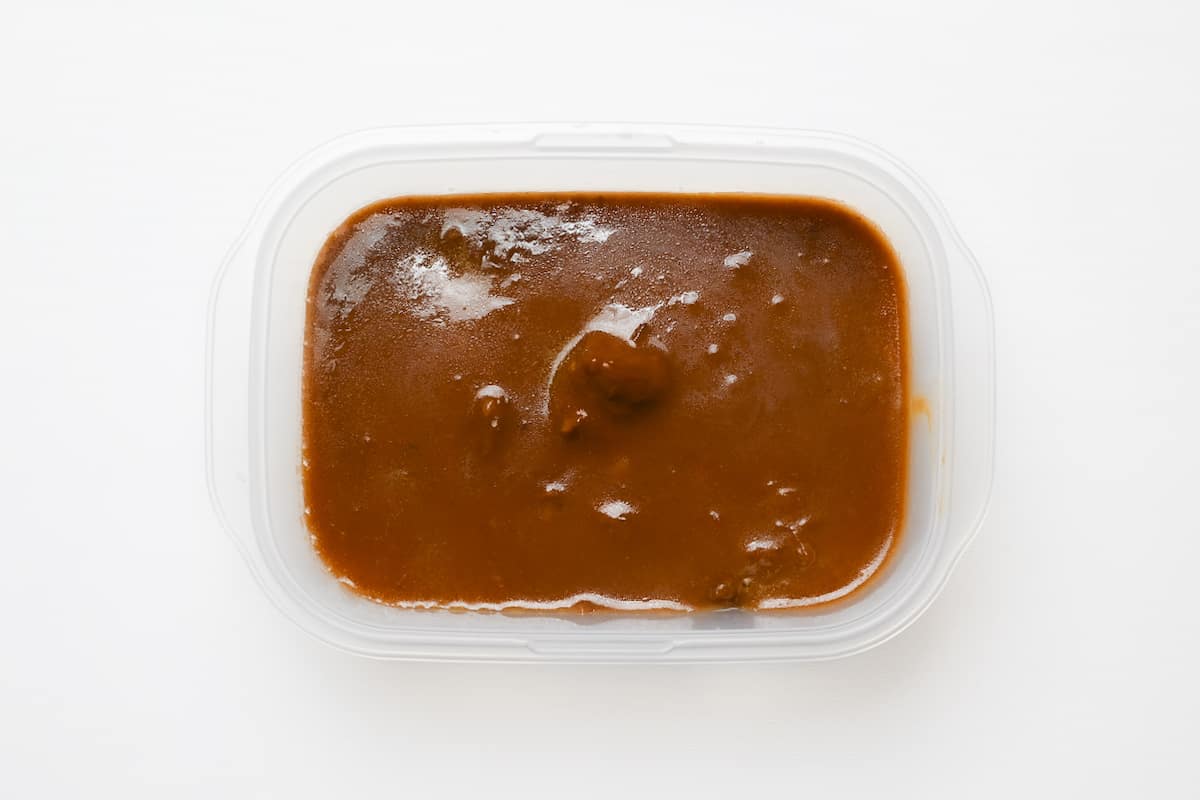
Next day curry is better? (Myth?)
What every Japanese family knows about curry is that “Second-day curry is the best curry,” meaning Japanese curry tastes better the next day than on the day it’s cooked. As a Japanese person myself, I think that is true. Well, I did some research and found a scientific reason for that.
Overnight, the ingredients (vegetables and meat) in curry start to give out “umami” (glutamic acid) as well as fructose, starch, fiber…etc.
So it generally builds up the depth of flavor and thickness overnight and becomes richer. Eating it the next day is better if you can wait! Or why not eat it two days in a row with different toppings and compare the difference?
I hope this post inspires you to try new ingredients and helps you make the best curry you’ve ever made! And if you don’t have access to Japanese roux cubes, check out my post on how to make Japanese curry from scratch here!
My favorite secret ingredient is coffee; I add it every time! What’s your favorite surprise ingredient? Comment below and let us know!
I hope you enjoy this Japanese Curry Using Roux recipe! If you try it out, I’d really appreciate it if you could spare a moment to let me know what you thought by giving a review and star rating in the comments below. It’s also helpful to share any adjustments you made to the recipe with our other readers. Thank you!
More Japanese Dinner Recipes
- Best Tonkatsu (Deep-fried Japanese Pork Cutlet)
- Hambagu (Japanese Hamburger Steak)
- Beef Hayashi Rice (Without Roux Packet)
- Japanese Style Mapo Tofu (Mabo Dofu)
- Teriyaki Beef Rice Bowl with Wasabi Twist
Want more inspiration? Explore my Japanese Dinner Recipe Roundup Post for a carefully selected collection of tasty recipe ideas to spark your next meal!
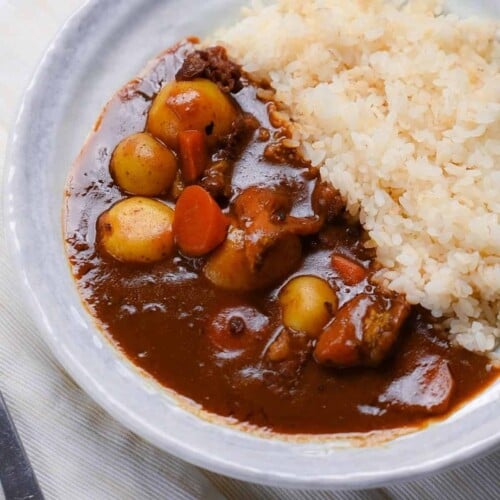
Japanese Curry Using Roux Cubes (Including Lots of Secret Tips)
Ingredients
Caramelized Onions (optional)
- 300 g onion
- 1 tbsp olive oil
- 1 pinch salt
- 1 tbsp water
Curry
- 300 g beef or protein of your choice, diced
- 1 tbsp butter
- 2 cloves garlic
- 150 g carrot
- 200 g potato
- ½ box Japanese curry roux approx 100g per ½ box
- 700 – 900 ml water or other liquid (see the post), this is an average, check the box for exact measurements
- 6 portions cooked Japanese short-grain rice approx 960g, or 3 rice cups (450g) before cooking
- secret ingredients of your choice I used red wine, coffee, dark chocolate, soy sauce – all optional!
My recommended brands of ingredients and seasonings can be found in my Japanese pantry guide.
Can’t find certain Japanese ingredients? See my substitution guide here.
Instructions
Caramelizing the onions (optional)
- Thinly slice 300 g onion. (The thinner the slices, the quicker they'll cook.) If you don't want to caramelize the onion, skip these steps and fry it later in the pot with the butter before adding the garlic and meat.

- Heat a pan on medium. Once hot, drizzle 1 tbsp olive oil and add the sliced onions.

- Fry the onions for 10 minutes, stirring occasionally so that they don't burn. After 10 minutes, add 1 pinch salt and mix well.

- Reduce the heat to low and continue cook for another 20-30 minutes, stir every few minutes prevent burning. (If the onions stick to the pan, add 1-2 tsp of water at a time to help unstick them.)

- While they're cooking, prepare the rest of the ingredients. Once they're complete, they should look something like this:

Making the curry
- Peel 200 g potato and 150 g carrot, and cut them into large pieces, slightly bigger than bitesize. (Try not to cut them too small otherwise they will fall apart during the cooking process.) Cut 300 g beef into bite size pieces.

- Heat a large pot on medium and add the 1 tbsp butter. (If you chose not to caramelize the onions, add them here and fry until softened.) Once it's melted, add 2 cloves garlic (grated or crushed) and fry until fragrant.

- Once the garlic is fragrant, add the meat to the pan and sprinkle with a pinch of salt. Brown the surface to seal the meat.

- Once the meat is seared, add the carrot and potato to the pot. Stir and cook together for a 1-2 minutes.

- Add the caramelized onion to the pot and stir thoroughly to break it up.

- Pour in 700 – 900 ml water (depending on your roux) and bring it to the boil. (If you want to add red wine, swap 10% of the water for the wine. Example: 850ml water becomes 765ml and 85ml of wine. You can also add tomato puree etc here if desired.)

- Once it's boiling, turn the heat down to medium-low and simmer for 20 mins with the lid slightly ajar.

- While you're waiting, check back from time to time and use a spoon to skim the foamy residue from the top of the simmering liquid. (If you want to add soy sauce, add it now)

- After 20 mins, turn the heat down to low and add your Japanese curry roux. Mix it until the roux has dissolved into the broth and simmer without a lid for 5-10 minutes or until thickened to your preference. (If it becomes too thick, you can add more water, 50-100ml at a time. If it's too thin, simmer for a little longer and check every 5 minutes.)

- Optional: If you want to add chocolate or coffee powder you can add them now.

- Once you reach your desired consistency, remove it from the stove.

- Serve with white rice and your favourite toppings, and enjoy!

Video
Notes
Nutrition
FAQ
Compared to Indian curry, I would say Japanese curry is less spicy but thicker and sweeter. And you can usually taste a little bit of a dashi-like flavor.
You can add 1 tbsp of water and flour mix slurry, but I don’t recommend doing that. Even if it’s thin, as you simmer, it will be thicker and thicker and richer the next day; I think patience is mostly needed here.
It depends on what kind of roux cubes you use. In Japan, there are usually three types and six levels.
• Sweet (level 1-2)
• Medium (level 3)
• Hot (level 4,5,6)
The sweet one is kids friendly, so it’s pretty sweet and not spicy at all; on the other hand, the hot one is quite hot (by Japanese standards, anyway).
It’s either カレーライス (Curry rice) or カレー (Curry)
It depends on your preference, but I like the following:
Java curry (ジャワカレー, Hot)
Golden curry (ゴールデンカレー, Spicy)
Vermont curry (バーモントカレー, Sweet)
And I usually get these three above and mix them rather than only using one brand.
Most standard Japanese-style curry contains cooked rice, curry roux, beef, potatoes, carrots, and onions.
The main difference between Indian and Japanese curries is the thickening of the curry. While most Indian curries are relatively thin, Japanese curries are characterized by flour’s thickening of the curry. Incidentally, Japanese curry was introduced by England rather than directly from India.
While 99% of Japanese households use premade curry roux cubes, you can make Japanese-style curry from scratch. If you’re interested, check out my Japanese beef curry from scratch recipe or chicken curry from scratch recipe.
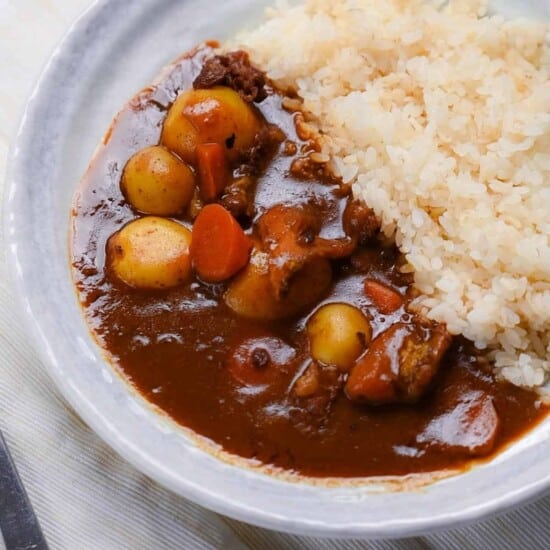



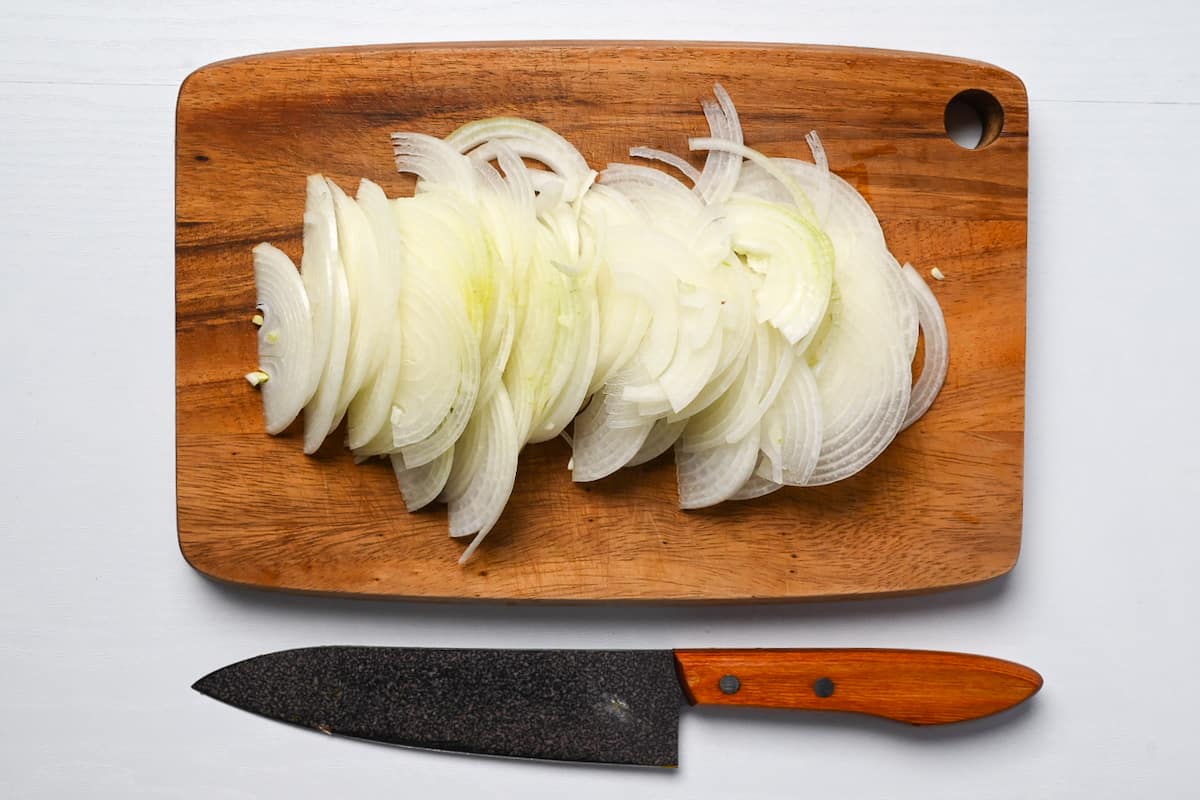
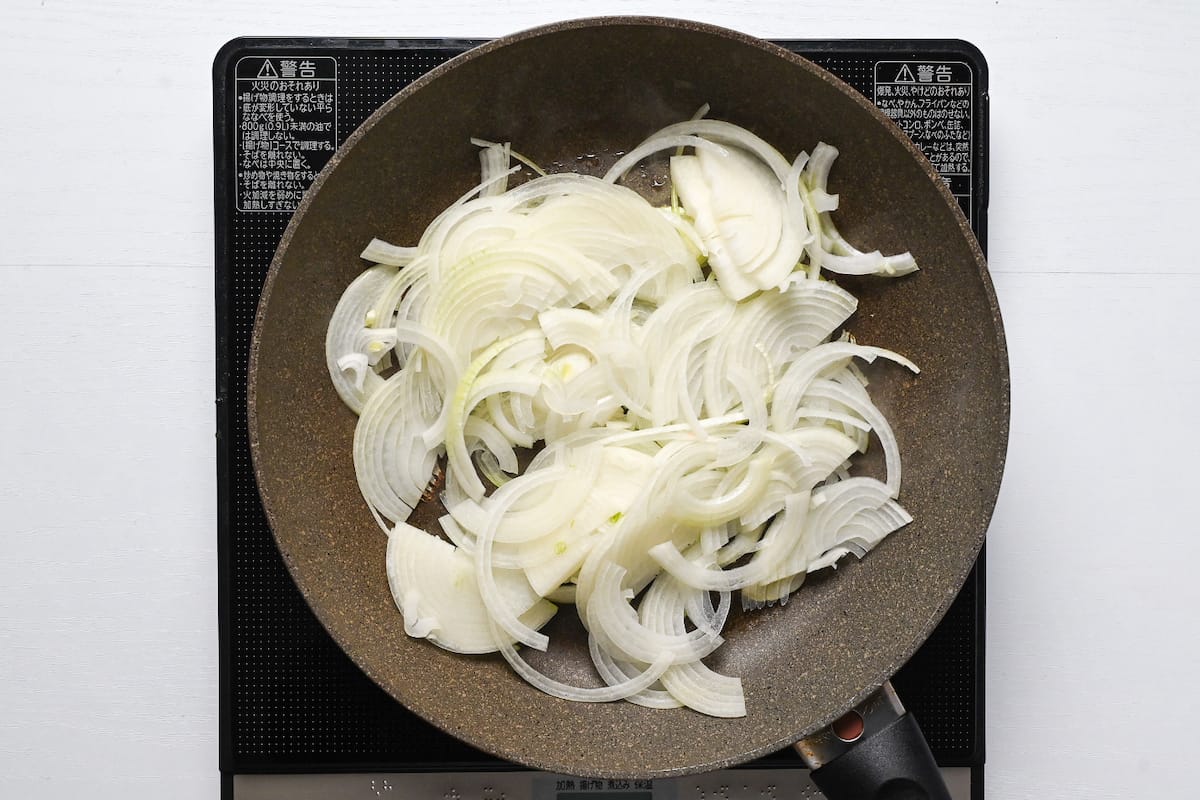
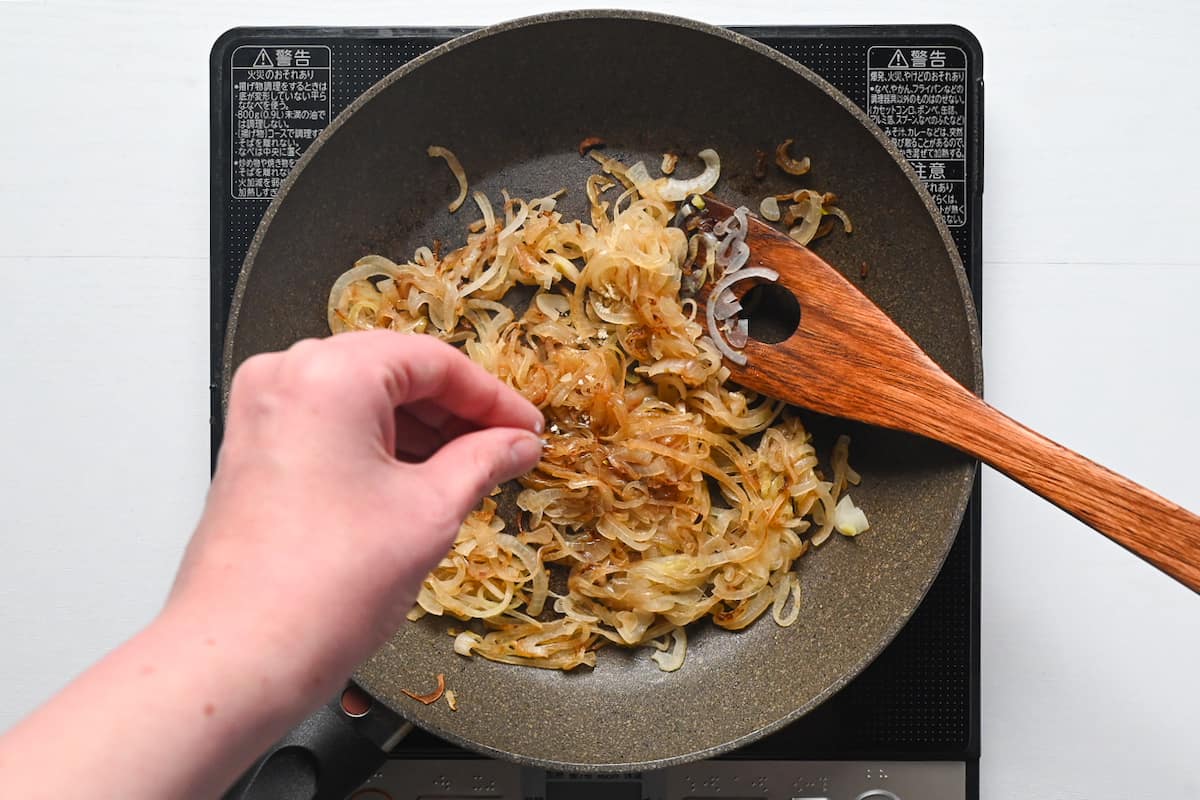
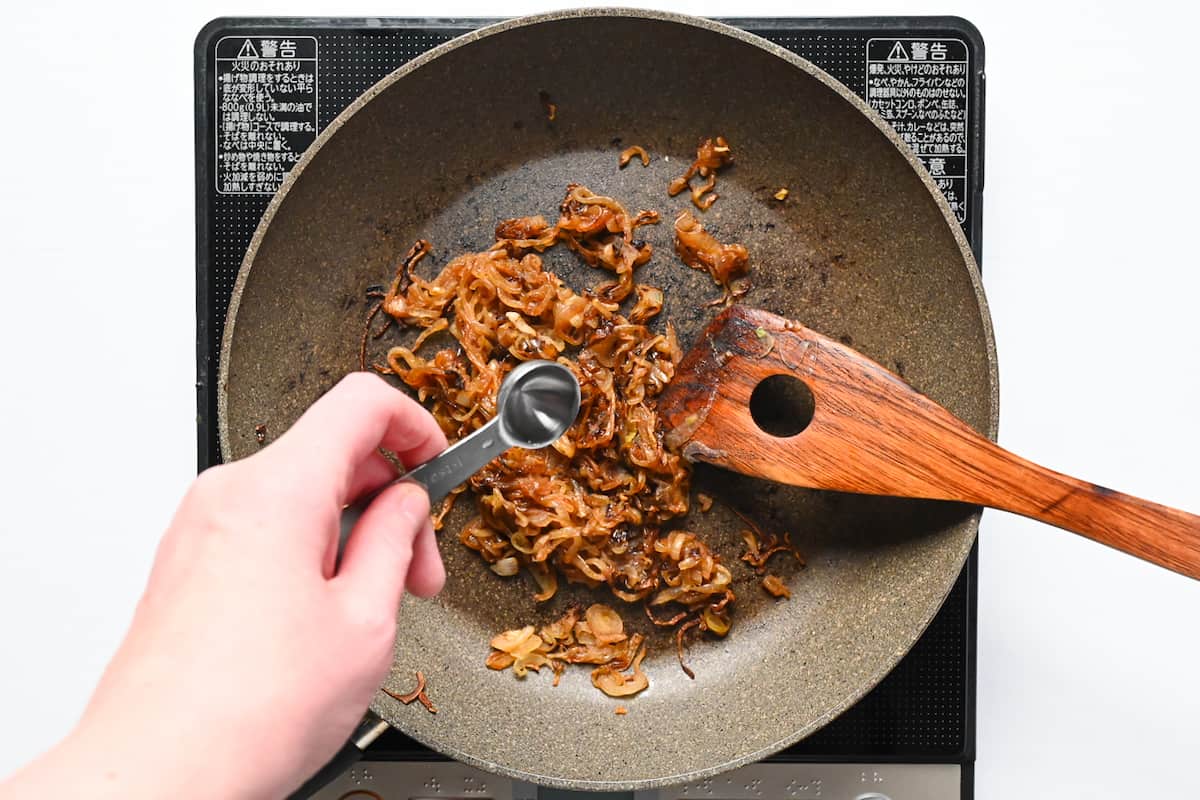
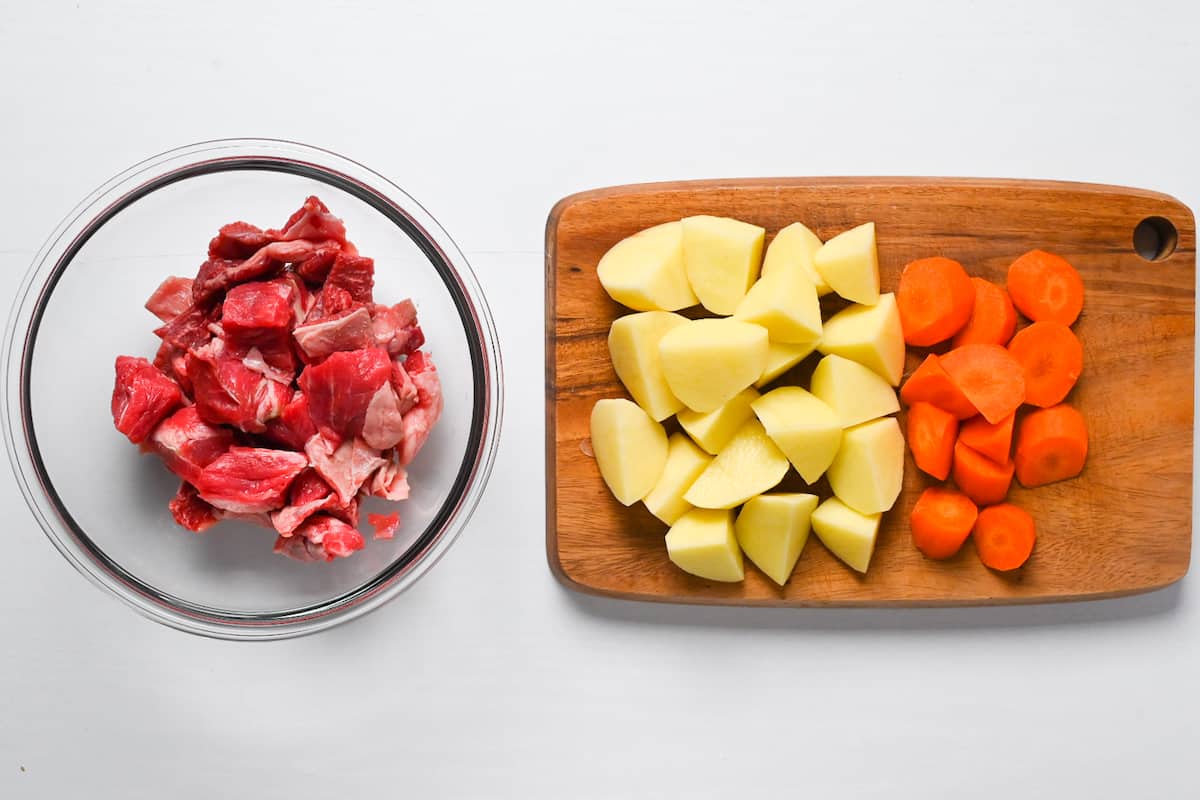
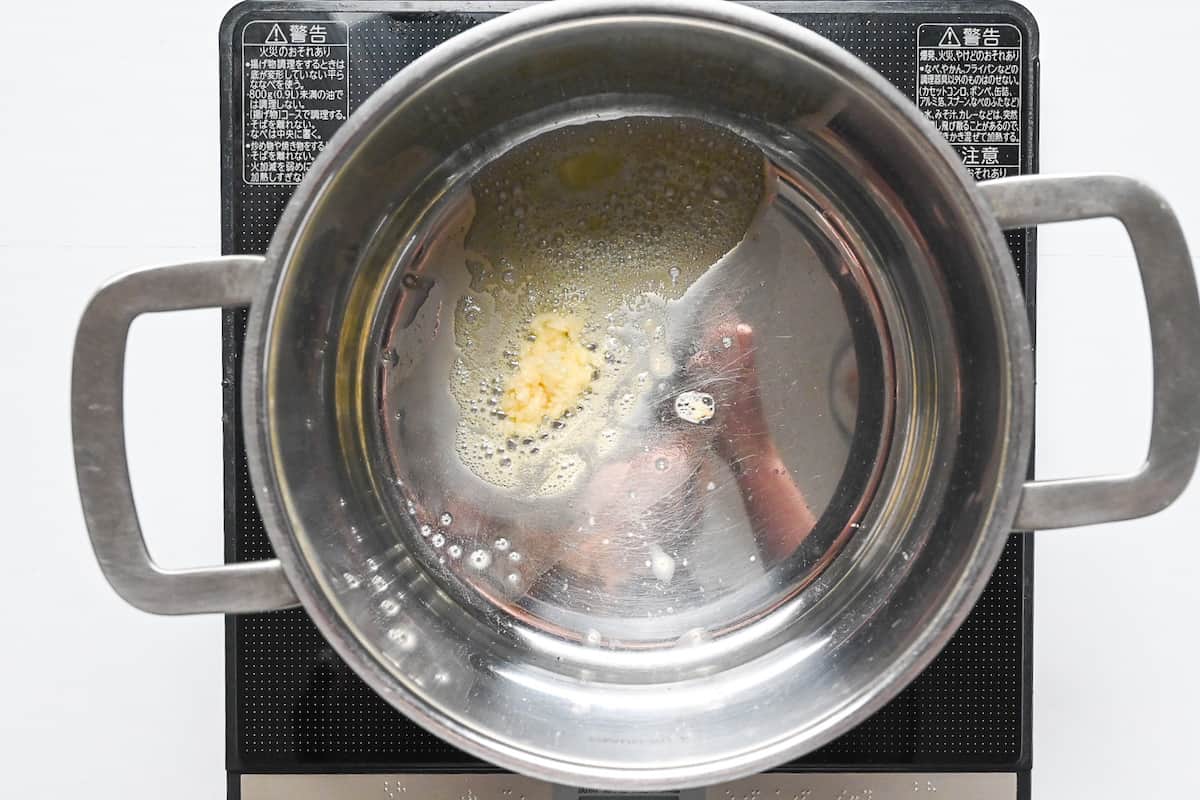
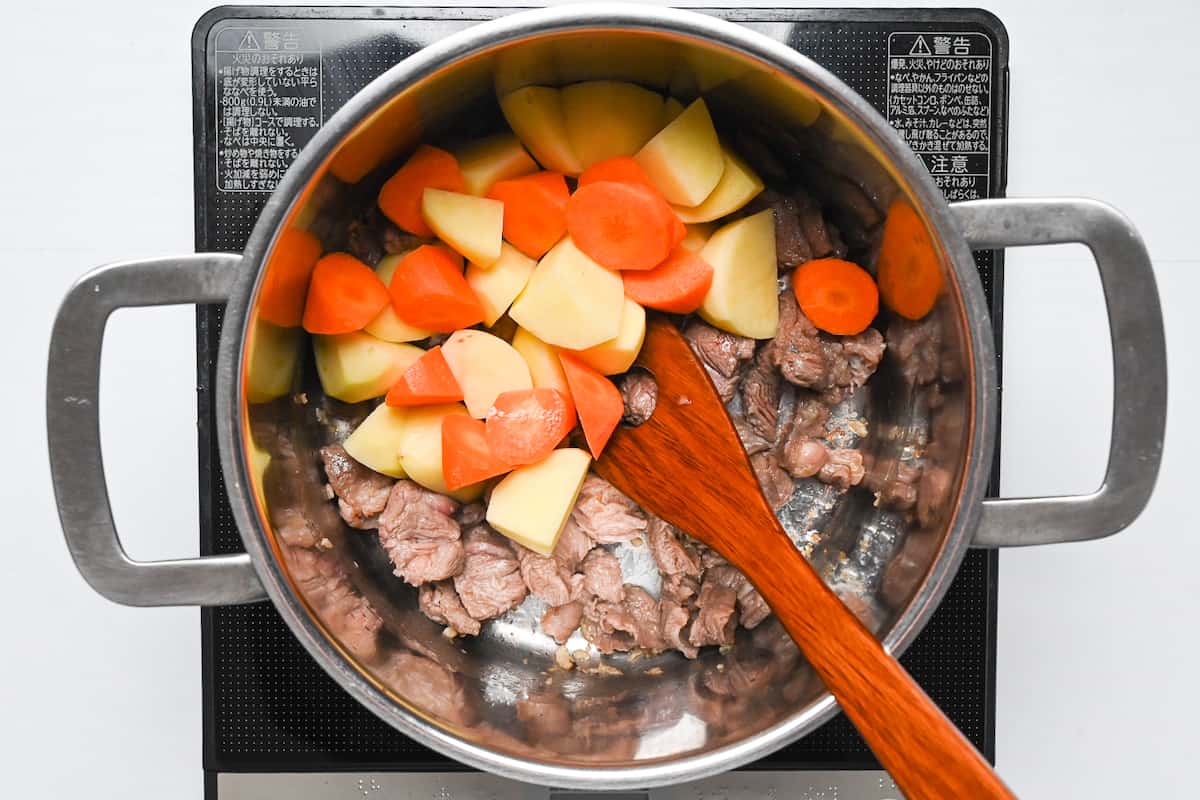
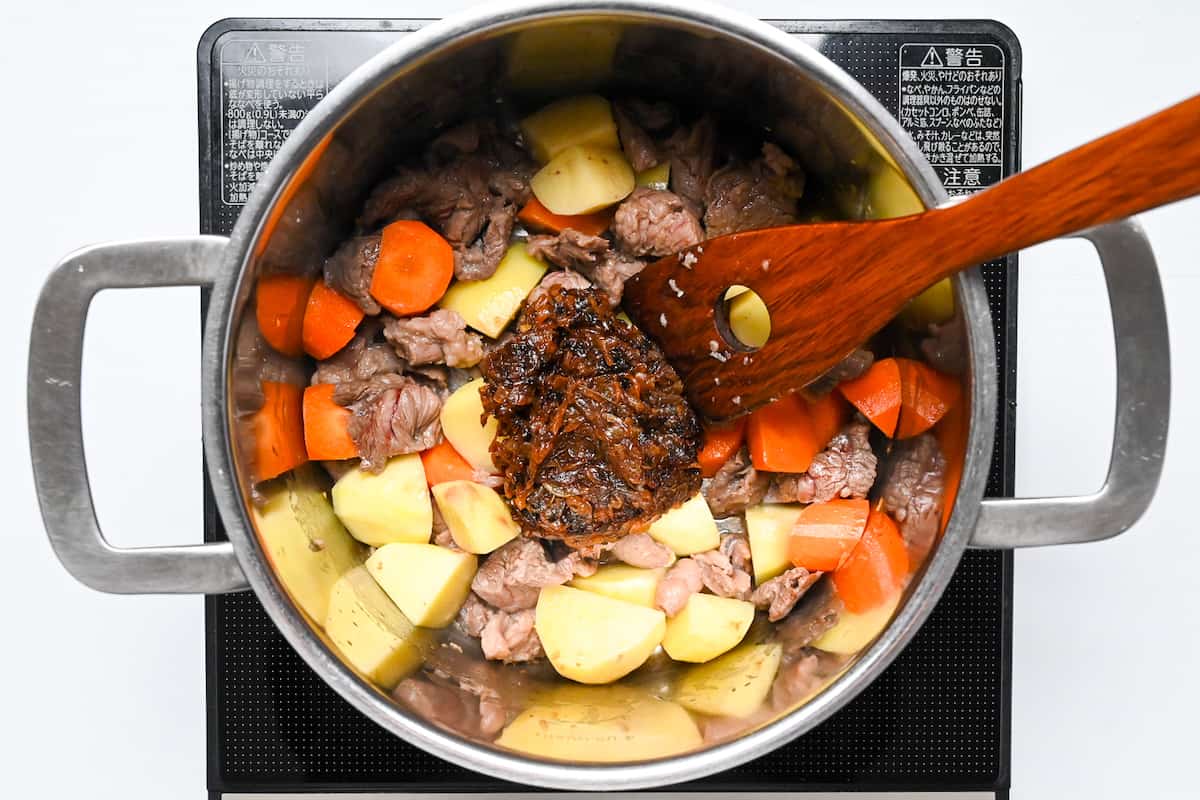
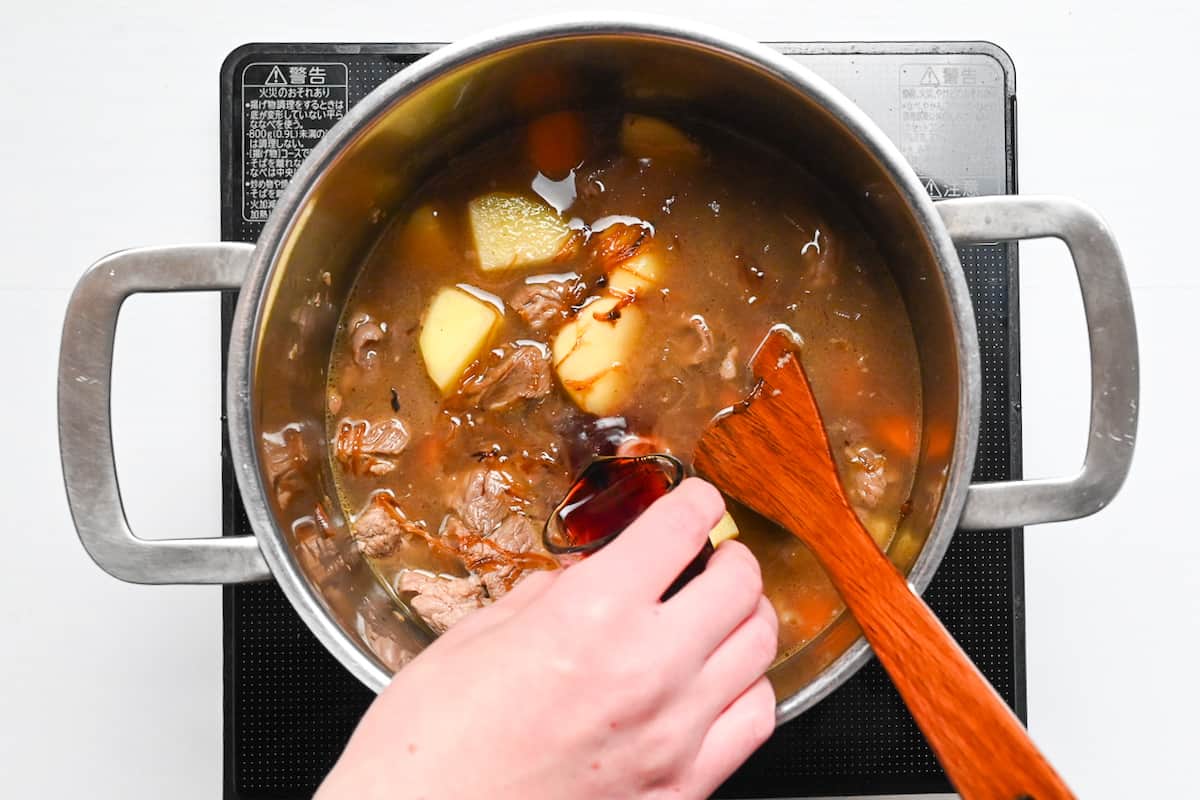
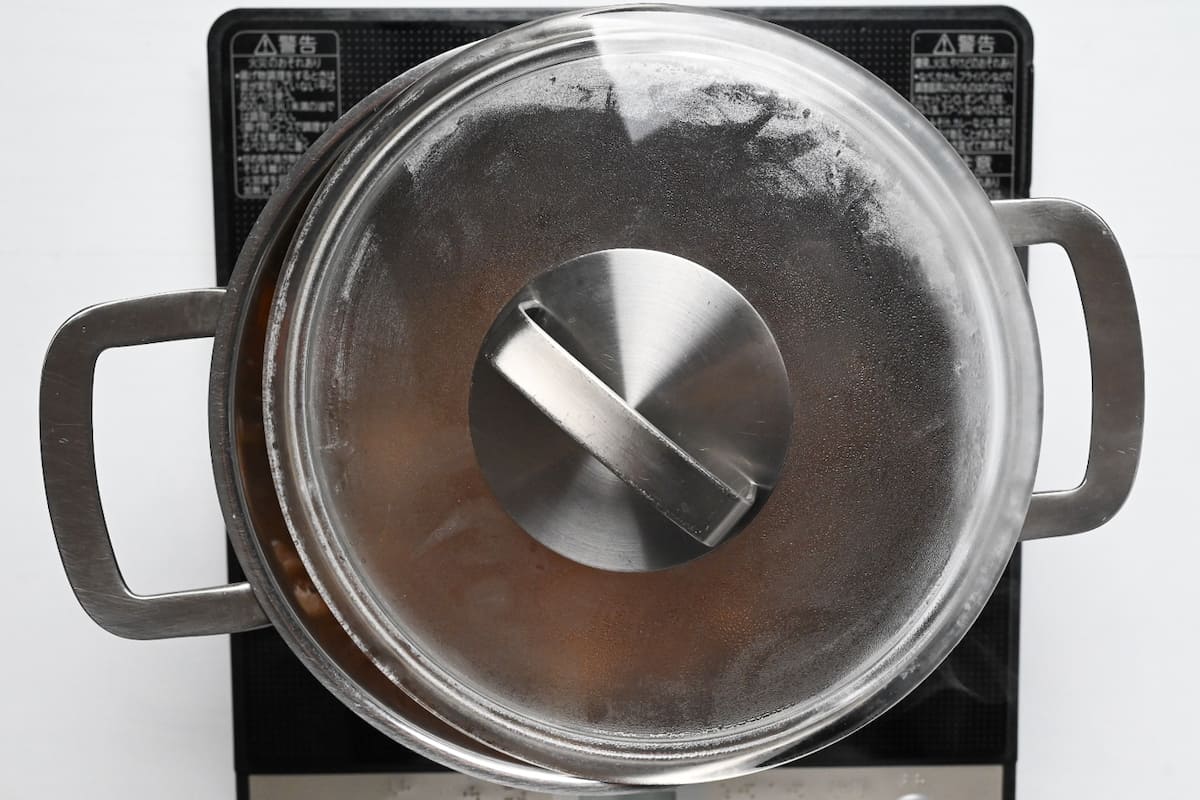
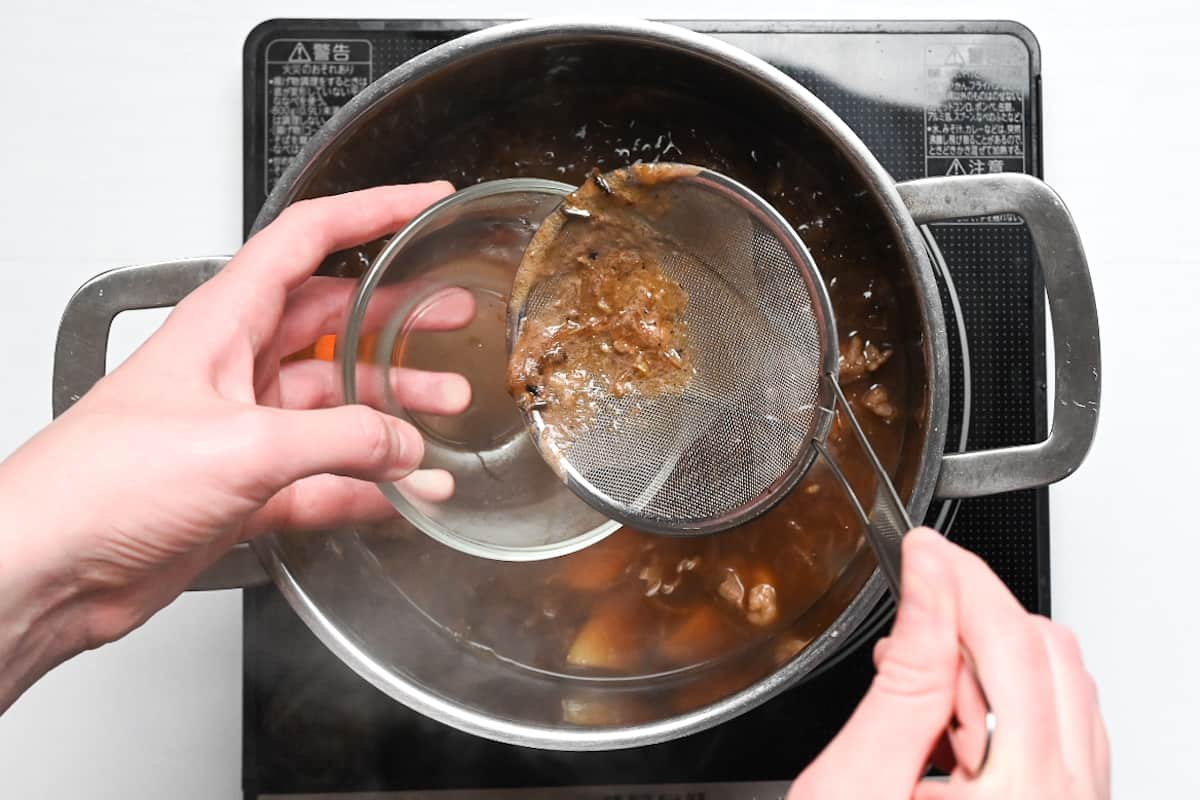
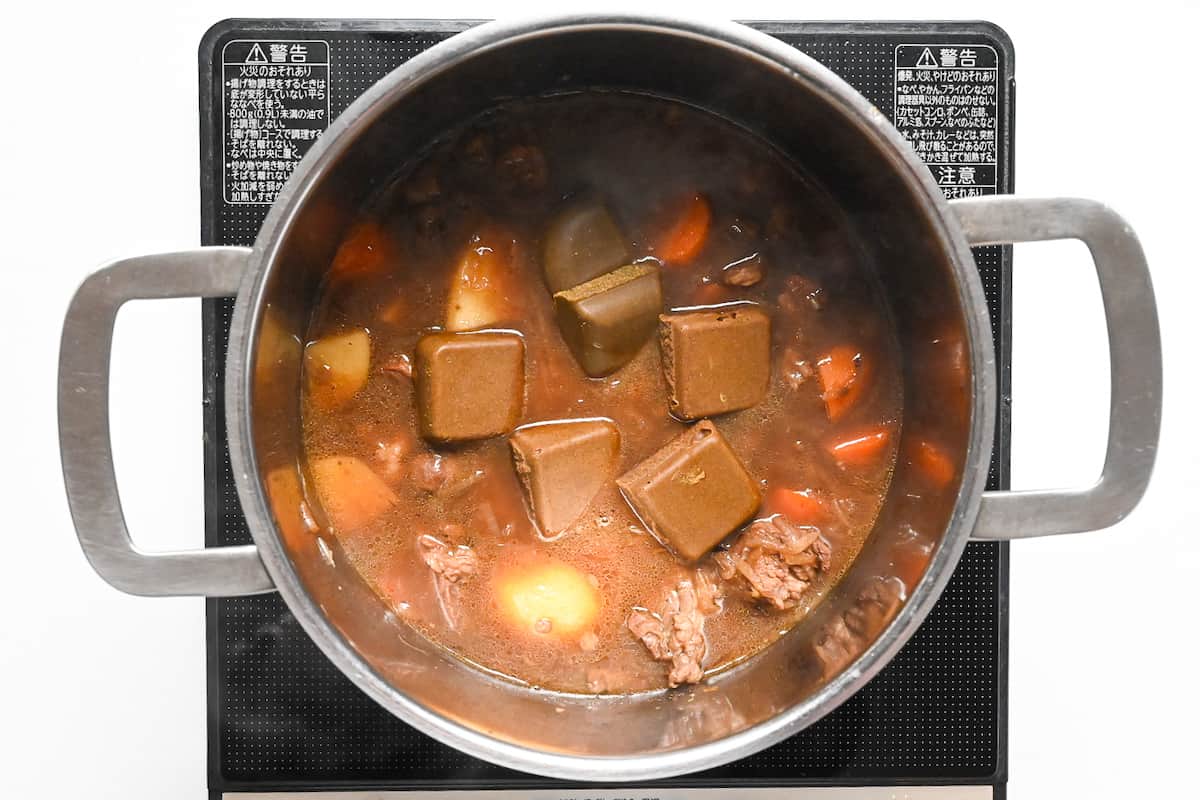
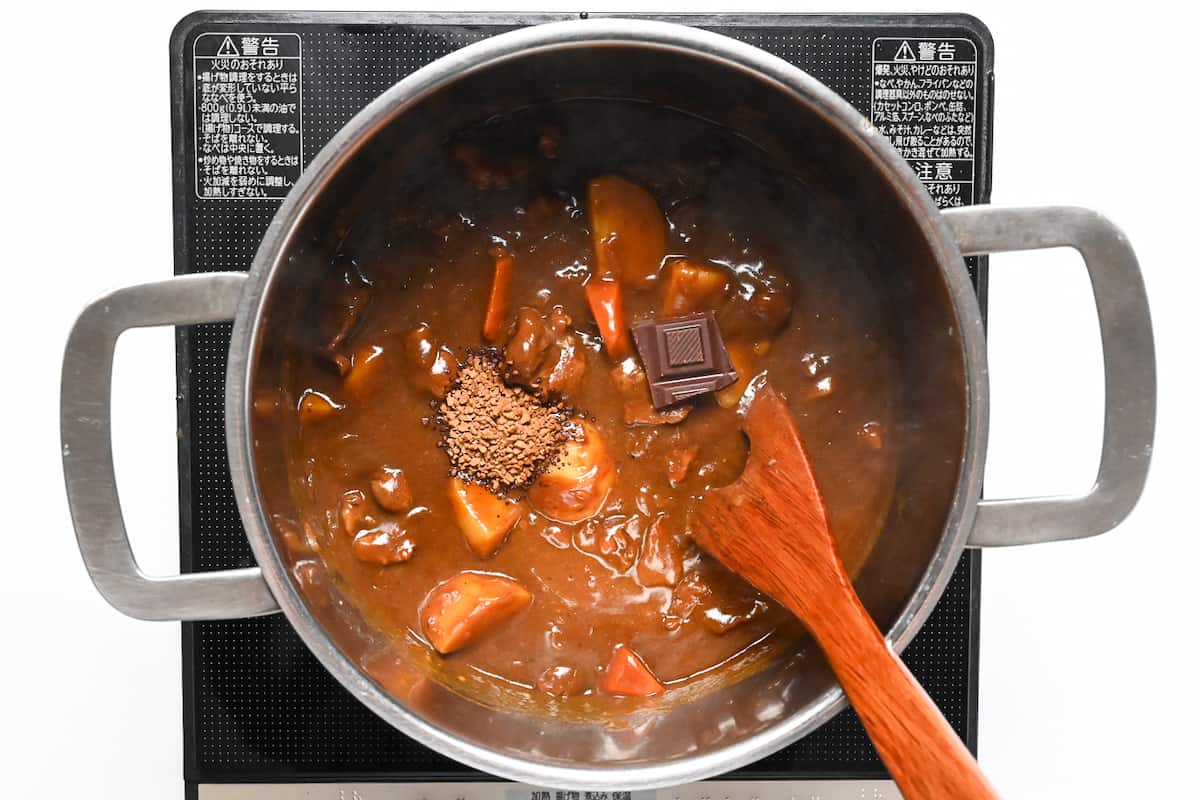
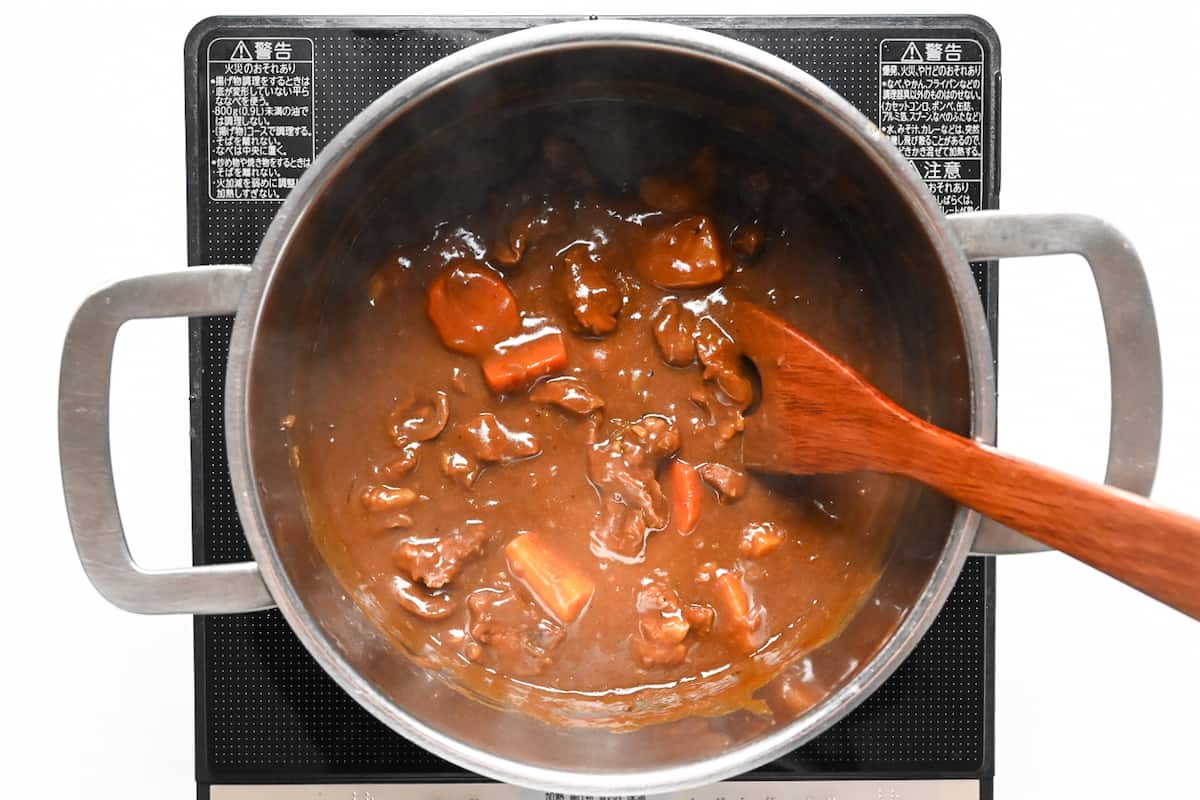
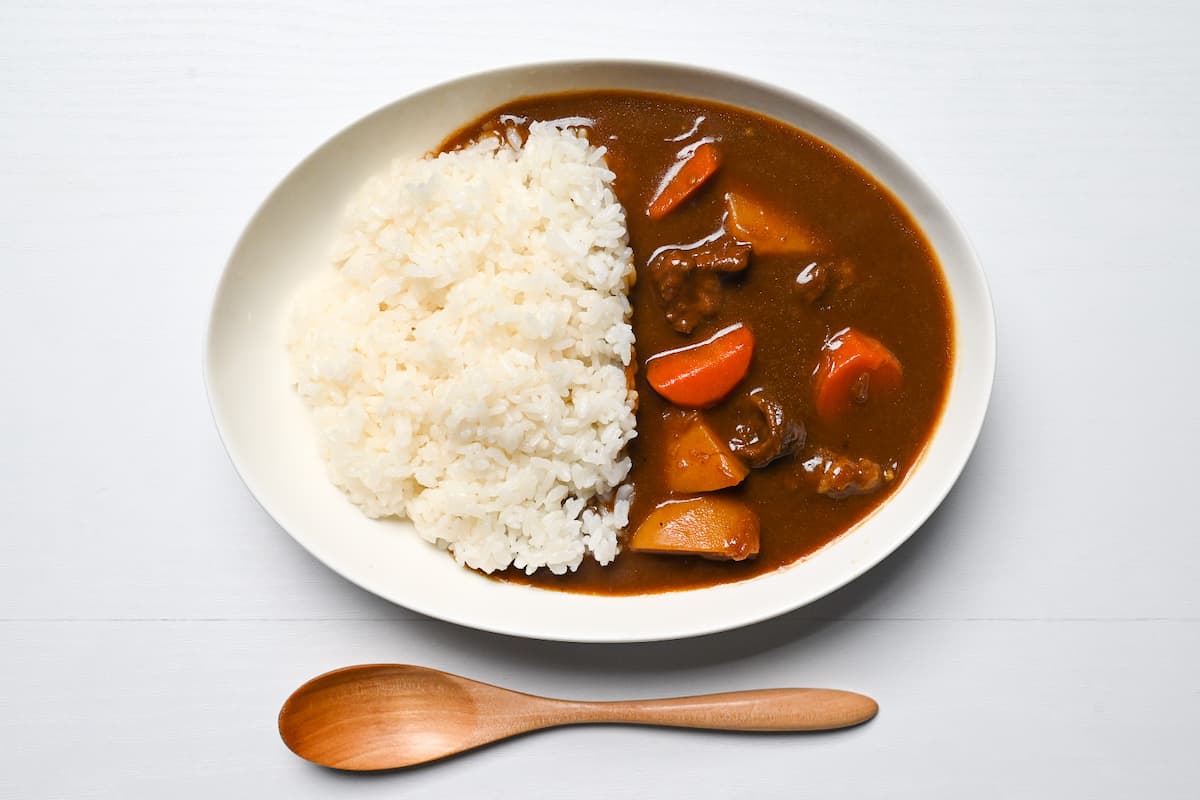
never tried the recipe but try adding, garam masala, oregano or coriander powder. Try one at a time and see which tastes better. You can also try adding them together as well.
Yes! I used garam masala and coriander powder in my homemade curry roux recipe. (https://sudachirecipes.com/homemade-japanese-curry-roux-recipe/) I haven’t tried adding oregano before, I’ll have to try it next time. Thanks for your suggestions!
Just made this. It was really good – restaurant good. I added soy sauce. Definitely wanna try adding coffee and chocolate next time.
Thank you Aj, it means a lot! Glad you enjoyed the recipe!
Tried this today – fantastic! I got the Vermont curry roux. Didn’t go with the caramelised onions option (just sauteed them), but on your suggestion added coffee powder and soy sauce (and then a little honey) – flavour was absolutely on point. So good! Thank you!
Hi Tricia, thank you so much for your comment and generous rating! Yes, caramelising the onions can be a bit time consuming, but I’m happy you enjoyed the other tips! 🙂
I really like adding a little grated ginger to mine- a couple teaspoons in the cooking liquid (usually I use unsalted chicken broth so it doesn’t get too salty with the curry). I love the ginger aroma! I also add grated Fuji apple, but next time I make it I’m also going to try the coffee- it sounds delicious!
Hi Marlena. Unsalted chicken broth is a great idea! I like to put grated ginger and apple too. Thank you for suggestions and the 5 star rating, I really appreciate it! 🙂
Thanks for the duration for caramelizing onion. I have been doing lately but I’m still unsure of the time needee. Will try that for dinner tonight.
WRT secrets ingredients, recently I tried adding doubanjiang (I got some extra from trying to make mapo tofu) and it taste good (to me anyway).
You’re welcome! It takes a while but it’s so worth it 🙂
I’ve never tried adding doubanjiang, but I think it’s a great idea! I’m gonna try it next time, thank you!
Thank you for all the tips!
I just made it and it tastes incredible. The best Japanese curry I’ve made so far. I caramelised the onions, added vegetable stock bouillon, bit of soya sauce, ketchup, coffee powder and (because I couldn’t find cocoa powder/plain chocolate), some chocolate peanut butter and a bit of cranberry flavoured chocolate).
However I bought beef cubes (pasture-raised) and it is somewhat still tough and it’s a little too salty for my liking (probably should not have added additional salt). Will try to improve on this next time by using different cut of beef.
Thank you, your tips have elevated my home cooked curry!
Hi Pearlyn,
It’s my pleasure! Thank you for trying out the recipe and tips, I’m so glad you liked it!
Do you know if your vegetable stock bouillon or peanut butter contained salt? That could have contributed to the saltiness.
I’ve actually never tried peanut butter in my curry, thanks for the tip!
For tougher beef that needs a longer cooking time, I would probably suggest simmering for 30 minutes extra before adding the vegetables and curry roux to help soften it up. It might also be softer the next day if you have time to keep it in the fridge overnight.
Thank you again for trying the recipe and giving your feedback, it means a lot!
Great recipe, really like the caramelized onion addition. Just a note the browning the meat to seal in juices is a common misconception. While browning improves flavor it doesn’t actually seal in juices.
Hi, thank you for your comment and rating, it means a lot and I’m glad you like the recipe!
You’re right, I’ve been seeing that more and more recently. But yeah I agree, I do think it’s important to seal the meat to improve the taste and texture. I’ve updated the post, thanks again!
Your curry recipe is amazing! The caramelized onions are delicious and loved the addition of soy sauce.
Thank you so much! Glad you enjoyed the recipe, caramelizing the onions is well worth the effort isn’t it?
Amazing recipe! I am already trying to buy the curry roux so I can make it this week. If I can’T find the hot Java curry and only mix Vermont and Golden how many of each should I use for the recipe?
Many thanks in advance!
Hi Natali!
Thank you for your comment and generous rating!
Your question is a little tricky because it depends on your personal preference. I recommend starting with 50/50 and then adjust from there, although this does depend on whether you bought mild/medium/hot. For example if one of them is hot but you don’t want it to be too spicy, you should use less of the hot one.
Vermont is 6 cubes in 1/2 a box and golden is 4, so I’d say 3 cubes cubes of Vermont and 2 golden with 725ml of liquid. I also recommend taste testing after adding the cubes, you can simmer it down to make it stronger/thicker or add more water if you find it too salty.
Good luck, let us know how it goes!
I just wanted to say thanks! I really like the carmeralized onions and adding chocolate! I also added bouillion cubes to the water and it taste amazing.
Try adding coconut milk to your curry
Thanks for the suggestion!
Great Site with great Recipes!!
What Type of Instant Coffee you use?
Thanks greetings fromm Austria
Oskar
Hi Oskar,
Thanks so much! It doesn’t need to be anything fancy, I just used Nescafe original! You can use any instant coffee you have in your cupboard 🙂
Thanks for your question.
Best wishes,
Yuto
omg eating bites as I type this comment, thank you for this recipe. I was scared of adding the coffee (dark roast). This extremely delicious and I’m enjoying it. Yummyy!!!!
Hi Elisa, glad you’re enjoying the recipe! Coffee is one of my favourite additions, I know it seems like a strange ingredient to use in curry but I’m glad you liked it too. Thank you for the feedback and 5 star rating!
All the best, Yuto
If using an Instant Pot, should the roux be added after cooking so that the liquid is slightly cooler. I added roux at the beginning and it never melted completely, so that there were clumps of it floating around.
Thanks!
I don’t own an Instant Pot or any similar product so I can’t comment much on this, but the roux needs to be mixed thoroughly while simmering. It doesn’t dissolve in cold liquid, but it should dissolve just fine in hot liquid (after mixing) with no need to cool it down. If I buy an Instant Pot in the future I will add more instructions to the post. Thanks for letting us know your findings.
hi, I haven’t tried this recipe yet, but saw this comment and thought I’d pass on a tip that works for me.
I grate the cubes into the pot so they melt and combine easier
Hi Trish,
That is a great tip! Thank you so much for sharing! 🙂
Yuto
I love putting dried grated orange peel in my curry!
Hi Cat,
I often add marmalade but I haven’t tried dried grated orange peel. Great idea!
Thanks for sharing 🙂
Love this recipe. The first time I made curry I just followed the instructions on the roux cubes. Then I stumbled upon this recipe and the caramelized onions plus other additions make it so delicious. Thank you for sharing!
Thank you! Glad you enjoyed the additions!
Made a white wine and seafood version of this recipe (with the coffee, caramelized onions, dashi, and soy sauce) and it’s one of the best things I’ve ever made. Thanks for the reipe!
Thank you very much for the comment and sharing your experience! Definitely made my day!
I have added coconut milk for a creamy flavour, tomato paste for richness and even lychee juice for sweetness – all in separate curries, I can’t imaging the taste of all of these in one curry!
Hi Manny,
Thank you for sharing your experience!
Yuto
I love this recipe, and as I’ve spent a lot of time in Japan I’m always trying to perfect my curry recipe- venison is my favourite at the moment! I just wanted to ask, a few times (most memorable in Tottori) I’ve eaten really dark curries, that are not necessarily more spicy but so flavourful! I have never figured out how to make it like that! It’s not Demi glace but definitely curry, just very dark brown. Do you know the kind I mean? Thank you so much for your fantastic recipes – they are always my first go to and have never failed me!
Hi AW,
Thank you for the comment and question!
There are a few possible reasons why a curry might have a dark color. One of the most common ways to achieve this is by roasting the spices, onions, flour, and other ingredients until it’s completely caramelized. Other times, the ratio of spice mix, simmering time, or the use of squid ink or black sesame may also contribute to the dark color.
In Japan, a restaurant chain called Gogo (55) Curry is well-known for serving dark curry. I heard their curry is made using a 55-step process and simmered for 5 hours, resulting in a rich, dark color.
While it’s not easy to replicate this level at home, the easiest way is to use caramelized onions and roasted roux (spices). Actually, my other curry recipe (https://sudachirecipes.com/beef-kare-raisu/), which involves caramelizing onions and roasting spices during the homemade roux preparation, results in a darker color compared to when using store-bought roux cubes.
I don’t know if this answers your question, but I hope it is helpful!
Yuto
I’ve made this a few times and my household loves it! I definitely like the additions of the Chocolate, coffee powder, and/or red wine. I’ve done some and I’ve done all of them together. Always good.
But I’d love clarification on this recipe on the number of grams of Curry Roux. Your recipe doesn’t change the number of grams when switching from 1x to 2x etc. And I’ve seen multiple box sizes. So when you say “approximately 100g” is that referring to the half-box and the 1x recipe? Or is a full box 100g and we should be added about 50g?
Hi Nathan, happy to hear your household is enjoying the recipe and thank you for the rating!
Thank you for pointing out the problem with the recipe card, I’ll look into that and get it fixed ASAP. As for giving exact weights for the curry roux, this is difficult because as you said, all the box sizes are different depending on which brand you use.
Most full standard boxes of curry roux range from about 185-230g and many (but not all) are divided into half box “packs” that serve 4-6 portions per pack (or 8-12 for a whole box/2 packs). This recipe uses 1/2 a box (or 1 pack) of curry roux for 5-6 portions, but there are some brands like Vermont that sell small 115g boxes (6 portions) and in that case you would use the whole box. The 100g approximate is there because there is no “one size fits all” measurement for boxes of curry roux, but it also doesn’t need to be exact.
Hope this helps!
Yuto
thank you very much. I’ll Cook curry for my family with your unvaluable help <3
Thank you, Sani!
Yuto
We love カーレライス. Never thought of of some of these additions though. I think we’ll try the coffee addition and s little red wine tonight! Thanks for a great site for Japanese recipes.
Hi ランディ,
Thank you so much for your comment! I hope you will enjoy these additions! 🙂
Yuto
Made this for dinner 2 nights ago. I didn’t add any carrots. Used 1 white onion, beef sirolin tips, and used beef bone broth instead of water. It was absolutely delicious. I added Kyoto furikake on top.
Hi Shanon,
Thanks for sharing your wonderful photo and experience! The results look fantastic. I’m happy to hear you enjoyed making this recipe!
Yuto
Used the SB Very Hot Curry cubes. They are not as hot as I expected. Amp up the heat with your choice of heat. I threw this together using leftover grilled onions, pork tenderloin, fresh carrots, potatoes, mushrooms and yellow pepper. Mushrooms and pepper were in the fridge so I used them. The only addition to this was a can of coconut milk. Simmer until the veggies are tender, served over rice and BANG, delicious! Don’t be afraid to make this your own!
Hi Christina,
Thank you for sharing your creative adaptation! Love how you transformed leftovers and fridge ingredients into a delicious curry. Really appreciate your encouraging comment about customizing the recipe!
Yuto
I had everything on hand so I pulled it together for dinner. I did use what I had on hand for veggies – broccoli, cauliflower, bell pepper, fingerling potatoes and threw in bok choy last. Added a full can of coconut milk at the end to thicken and add another dimension. Served over rice and cilantro on top. Fabulous!
Hi Chris,
Thank you so much for trying this recipe and sharing your experience! I’m happy to her you enjoyed it! 🙂
Yuto
Thank you so much for this! I added some coffee, butter, ginger, honey and some grated apple. Usually when I make japanese curry its too mild and tastes only of onions. Not this time! It was delicious! I’m definitely using these tips again.
p.s. for some reason it wouldn’t let me rate 5 stars.
Hi Allison,
Thank you for trying this recipe! So happy to hear it turned out flavorful for you! Love the additions you made. And thank you for the heads-up on the rating issue, I’ve just fixed the system! 🙂
Yuto
This was yummy, thank you. I mixed this and another recipe together using my instant pot and the family was content. Saving for next time.
Hi EK,
Thank you so much for trying! Love that you made it your own. Happy to hear everyone liked it! 🙂
Yuto
Delicious!
Thank you, Paris!
Thank you for for offering so many suggestions for the “secret” ingredients! I love how creative the cooking process was – I had a lot of fun making it, and it turned out amazing. I know it’ll come out different every time I make it. I’m excited to try out other variations.
My “secret ingredients”: a juice blend with carrot, green apple, and orange; the juice of a handful of rainbow-cherry tomatoes, a dash of soy sauce, minced ginger, and dark chocolate with sea salt to taste (~12 g).
I made the curry with jumbo shrimp. I cooked them through after caramelizing the onions, and removed them to simmer the sweet potatoes and let all the flavors come together. I added the shrimp back in towards the end. I served the curry with jasmine rice and soft boiled eggs.
Hi Michaela,
Thank you for your comment! I really appreciate you taking the time to share your take! The flavors you added sound amazing, and I’m so glad you’re having fun experimenting with different variations each time. 🙂
Yuto
5 stars!!! First time cooking curry somewhat from scratch (i used to buy ready made sauce with a couple pieces of potato and carrots, no protein), but saw yellow vermont curry cubes at the store and decided that IT’S A SIGN!
Made it with chicken and skipped the caramelised oinions step (sorry), and it turned out so good!!! I also added some mushrooms (threw them in with carrots and potatos) and they were so tender and juicy.
Overall great recipe, i really appreciated the lengthy reviews of stuff/nuance because often when i read some recipes they leave more questions than they give answers. Well, not in this case! So, thank you!
Also here’s my humble lunch. I kind of overdid it with the vegetables and could use more of the sauce itself, but i will keep this in mind for the next time. Served with rice and steamed string beans. Thank you againg!
Hi Tan,
Thank you so much for trying the recipe and for sharing your photo & experience! It looks wonderful, and I’m so glad you enjoyed it and found the post helpful. I love your twist with the mushrooms and extra vegetables! That’s the beauty of this curry, it’s so versatile! 🙂
Yuto
Great recipe!!!
Hi Cecilia,
Thank you so much for making and sharing your picture! Looks great! I’m happy that you enjoyed it! 🙂
Yuto
Love Japanese curry! I’ve done a 14oz can of chicken broth with 14oz can of coconut milk instead of the water with the regular roux recipe. This helps to add a little more depth of flavor.
I haven’t tried with caramelized onions so I’m trying that next but I can’t wait to see how it changes the flavor!
Thanks a ton for the other tips and suggestions. I’ll be referencing this for further curry dinner nights (often!)
Love the site, thanks again.
Hi Garin,
Thank you so much for sharing your experience! That sounds delicious! Love your take with the broth and coconut milk! Really happy you’re enjoying the curry and finding new ways to make it your own. And thanks so much for the kind words! 🙏
Yuto
Made this for my son for dinner last night. He asked what restaurant I ordered it from. When I told him I made it, he said show me the recipe. I used the coffee, soy sauce, chocolate and beef broth. The only thing I changed, was instead of carrots I used water chestnuts. It was delicious! Thank you for making everything so easy to understand.
Hi Sunny,
Thank you so much for trying this recipe! That’s such a wonderful story! I love that your son thought so. Love your twist with the water chestnuts, too. Thanks for taking the time to share how it turned out! 😊
Yuto
VERY comprehensive and perfect for those of this just beginning to learn about Japanese curries and trying to find the right combinations for us. I live all of the suggestions. Extraordinarily helpful. THANK YOU!!
Hi RQ,
That means a lot, thank you! I’m happy you found it helpful and inspiring for your curry making! 🙂
Yuto
Thank you for putting this together! I’ll definitely use sone of these modifications, maybe not the wine because we don’t like the taste of alcohol in our food.
I once switched about a third of the meat with mushrooms, and I liked that too.
My dad likes to put a dollop of soured cream on top.
Hi Saeng,
Thank you so much for your comment and for sharing your experience! I’m glad to hear you found some of the suggestions helpful. Thanks again for taking the time to share! 🙂
Yuto
the recipe looks great but I’m confused about one thing – beef shank is one of the toughest and most collagen rich cuts, it can take hours just to start getting soft. No way is 20 minutes enough. Are we supposed to keep cooking the beef for hours, roux and all, until tender? what am I missing?
Hi Mathan,
Thank you for your comment! You’re absolutely right, I should have been clearer about this.
In the recipe card, the timing is written for bite-size pieces of quicker-cooking cuts (like chuck/shoulder or even pork/chicken), and the “shank + tendon” combo is more of a general suggestion in the blog post.
If you’d like to use true shank, I recommend simmering it first until tender and then adding the roux at the end, or choosing a cut like chuck that will work within the written cooking time. I’ll add a note to the recipe to make this clearer. Thank you so much for pointing it out!
Yuto
Thanks so much for such a thorough deep dive into this topic and for explaining how each step and ingredient affects the final result. I learned a lot, and now I have so much inspiration that I’ll probably never run out of new ideas for Japanese curry. Today I tried S&B Hot Golden Curry cubes with caramelized onions and a bit of dark chocolate. The flavor was incredibly rich and the result was absolutely top-notch.
Hi Marcin,
Thank you so much for giving it a try and sharing your photo! It looks fantastic. I’m really glad that the caramelized onion + dark chocolate combo hit the spot!
Yuto